Ready to bring some serious warmth and personality into your kitchen? Mexican design isn't just about throwing up some colorful tiles and calling it a day. From authentic hacienda vibes with hand-painted murals to sleek contemporary spaces that blend tradition with modern living, these 20 Mexican kitchen ideas prove there's a style for every taste. Whether you're drawn to rustic adobe walls, vibrant Talavera ceramics, or that perfect indoor-outdoor flow, you'll discover how to create a space that's as functional as it is stunning. Let's dive into designs that'll make your kitchen the heart of your home.
1. Traditional Hacienda Mexican Kitchen Design

Authentic hacienda Mexican kitchens feature spacious layouts with horseshoe-shaped counters, exposed wooden beams, and tiled braseros where charcoal-burning stoves were traditionally placed. This design incorporates weathered wood cabinets with hand-carved details, natural stone countertops, and Talavera tiles that burst with color and life, telling stories through meticulously crafted patterns. The walls showcase textured plaster finishes in warm earth tones, while wrought iron chandeliers provide ambient lighting. Large wooden tables serve as both preparation surfaces and gathering spaces, often featuring thick sides and pegged legs reminiscent of traditional mesa de moler grinding tables. Clay pottery displays and copper cookware complete this timeless aesthetic that honors centuries-old Mexican culinary traditions.
2. Modern Talavera Mexican Kitchen with Contemporary Elements
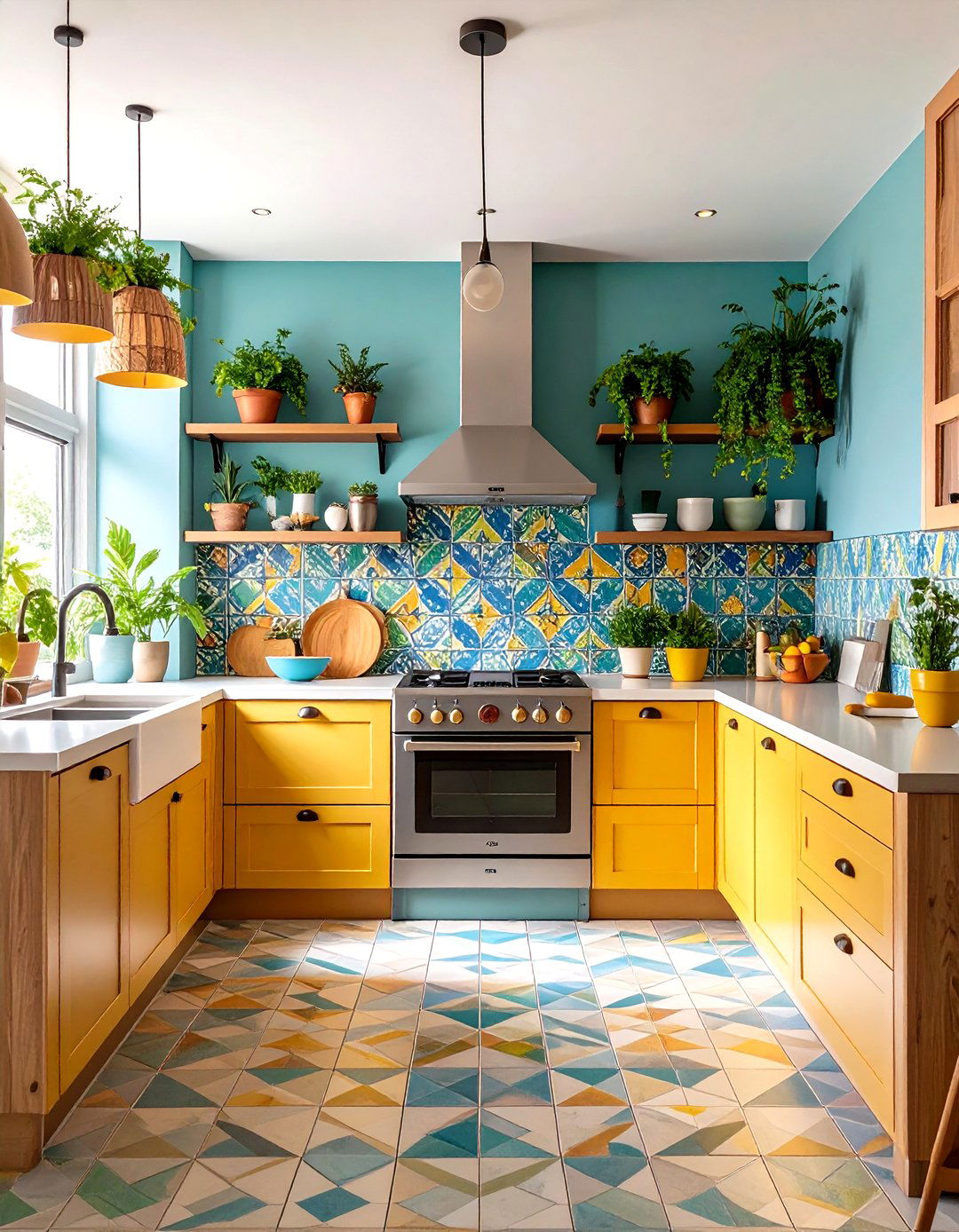
Contemporary Mexican kitchens blend biophilic design with clean surfaces and sustainable materials while incorporating traditional Talavera elements. This style features sleek cabinetry in neutral tones accented by hand-painted Talavera tiles in vibrant blues, yellows, and greens arranged in geometric patterns across backsplashes. Modern appliances integrate seamlessly with traditional elements, while large format tiles create continuity throughout the space. Cement tiles in contemporary patterns complement the traditional Talavera work, offering encaustic-style designs that match modern kitchen themes. Natural lighting emphasizes the tile artwork, and minimalist open shelving displays curated Mexican ceramics. This approach successfully marries centuries of artisan tradition with practical functionality for today's cooking needs.
3. Rustic Colonial Mexican Kitchen with Authentic Materials
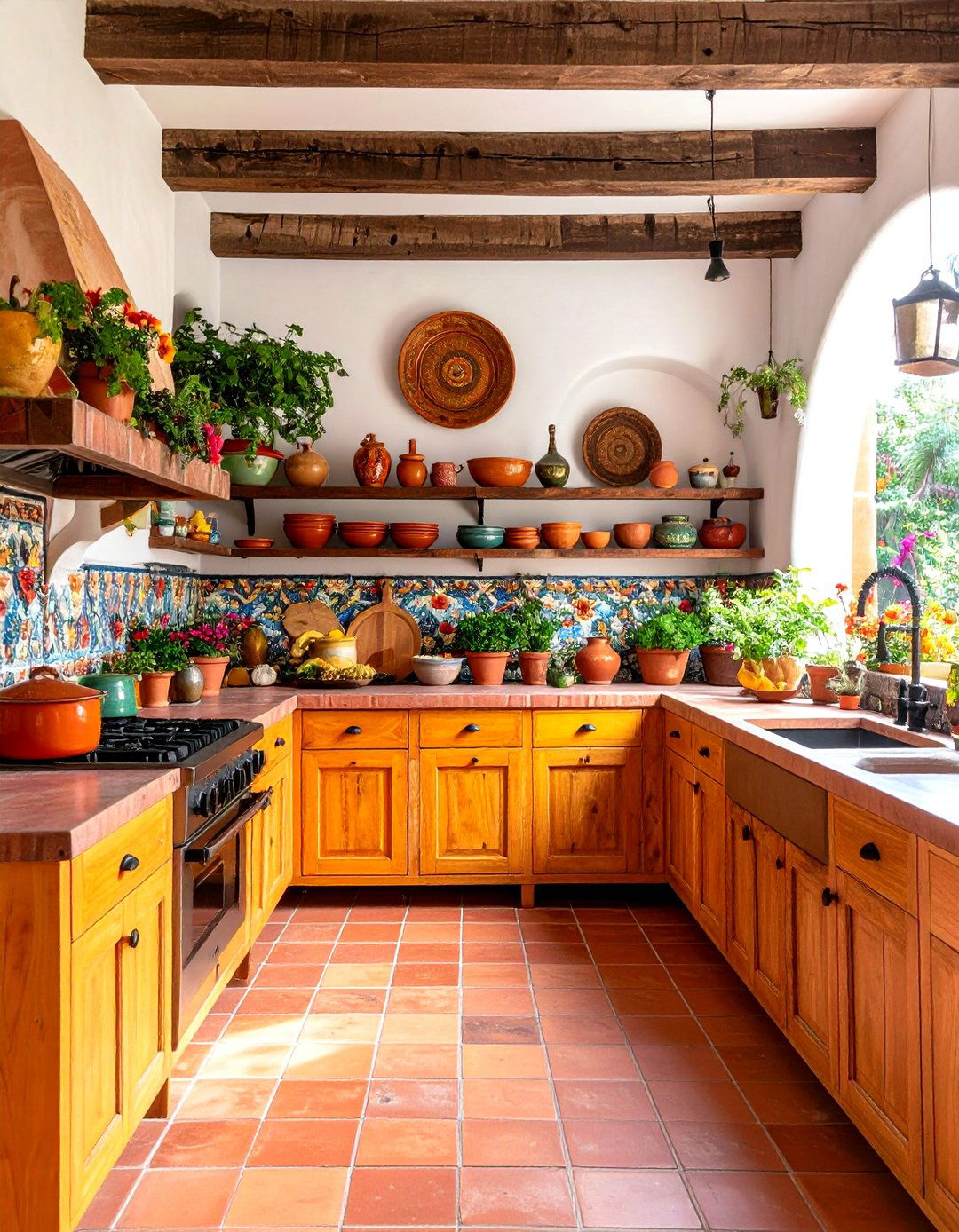
Embracing the colonial heritage, this Mexican kitchen style showcases natural traditional materials like aged wood, clay, and wrought iron combined with modern fixtures that work alongside old-world elements. Distressed wooden cabinetry features hand-forged iron hardware, while terracotta Saltillo tiles or natural stone flooring maintains the earthy, traditional foundation. The design incorporates arched niches for storage, reminiscent of colonial monastery kitchens, and rustic wooden furniture with ornate carvings that carry styles from centuries past. Exposed brick walls complement textured plaster surfaces, while traditional clay pottery and wooden utensils serve both functional and decorative purposes. This style celebrates Mexico's colonial past while providing all modern conveniences for contemporary living.
4. Contemporary Mexican Kitchen with Bold Color Palettes
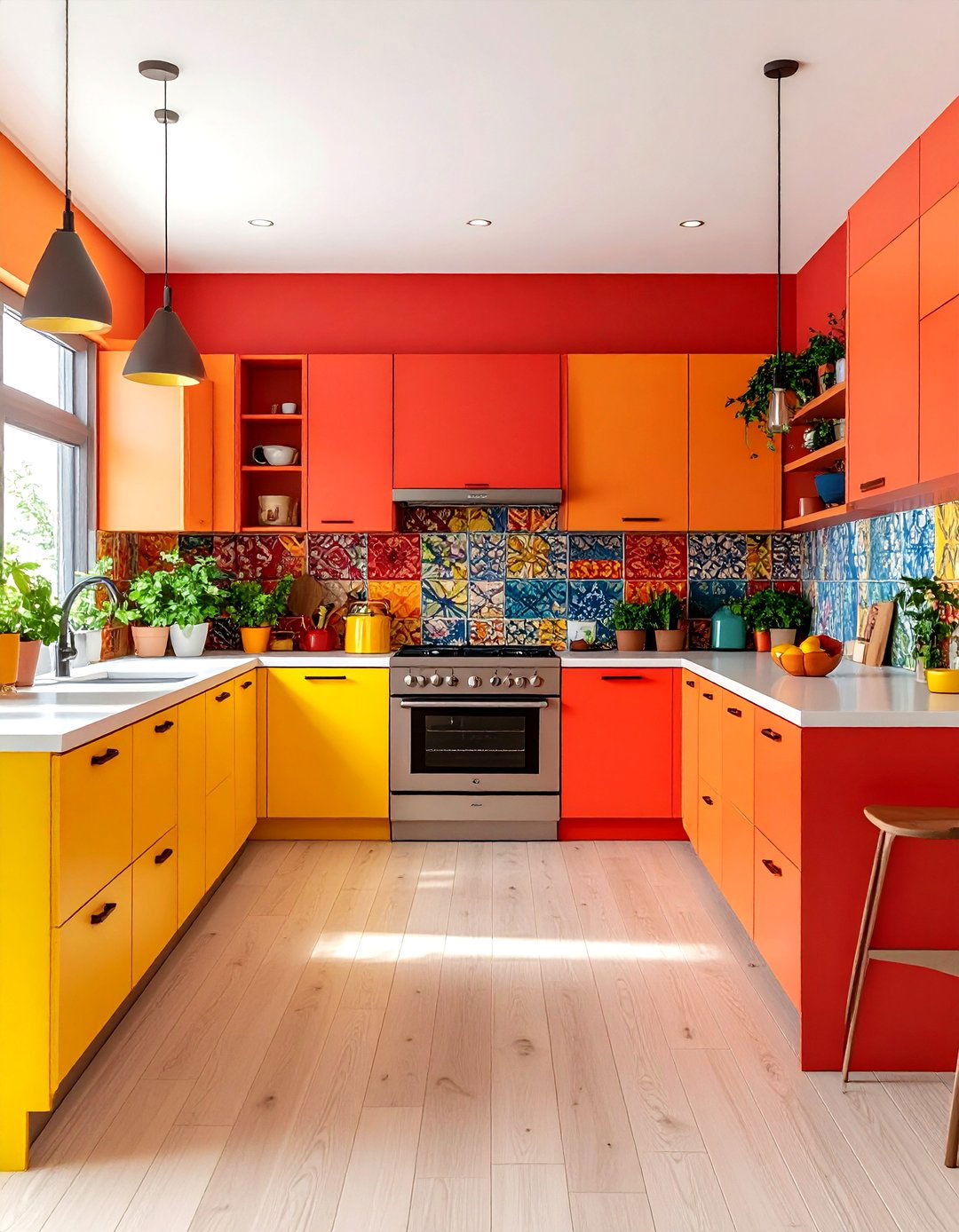
Bold color palettes featuring bright reds, yellows, oranges, and blues form the foundation of this vibrant Mexican kitchen design. Modern cabinetry in deep jewel tones contrasts with white quartz countertops, while rich reds and yellows appear in cabinet choices as homeowners take more design risks. The backsplash features contemporary interpretations of traditional patterns using large-format ceramic tiles in saturated hues. Stainless steel appliances provide sleek functionality against the colorful backdrop, while pendant lighting in wrought iron finishes adds Mexican character. These bold hues evoke warmth and energy, reflecting Mexico's rich cultural heritage while creating a lively, welcoming atmosphere. Open shelving displays colorful dishware and Mexican glassware, completing this exuberant modern interpretation.
5. Minimalist Mexican Kitchen Design with Neutral Tones
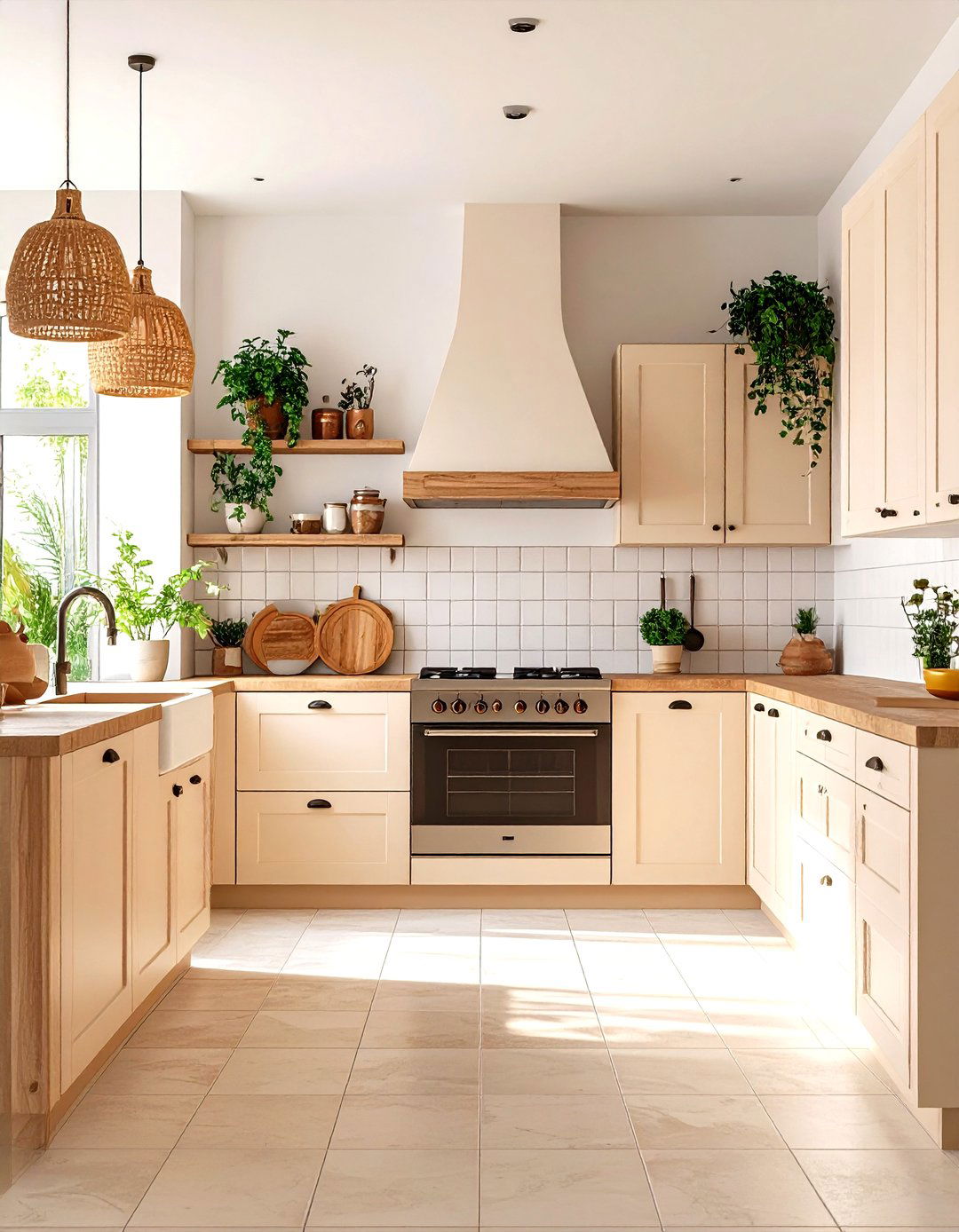
Functional minimalism with clean surfaces and neutral colors creates a calm, timeless interior aesthetic while honoring Mexican design principles. This approach features streamlined cabinetry in warm beige or cream tones, complemented by lush, solid-colored tiles combined with subtle Talavera accents. Natural materials like light oak or pine provide warmth without overwhelming the space, while simple wrought iron pulls add authentic Mexican touches. The backsplash incorporates single-color handmade tiles in earth tones, creating texture without busy patterns. Large windows maximize natural light, emphasizing the connection to Mexico's privileged climate. Carefully curated pottery pieces and a few strategically placed plants provide subtle color while maintaining the serene, uncluttered aesthetic that defines modern minimalist Mexican design.
6. Mexican Courtyard Kitchen Style with Indoor-Outdoor Flow
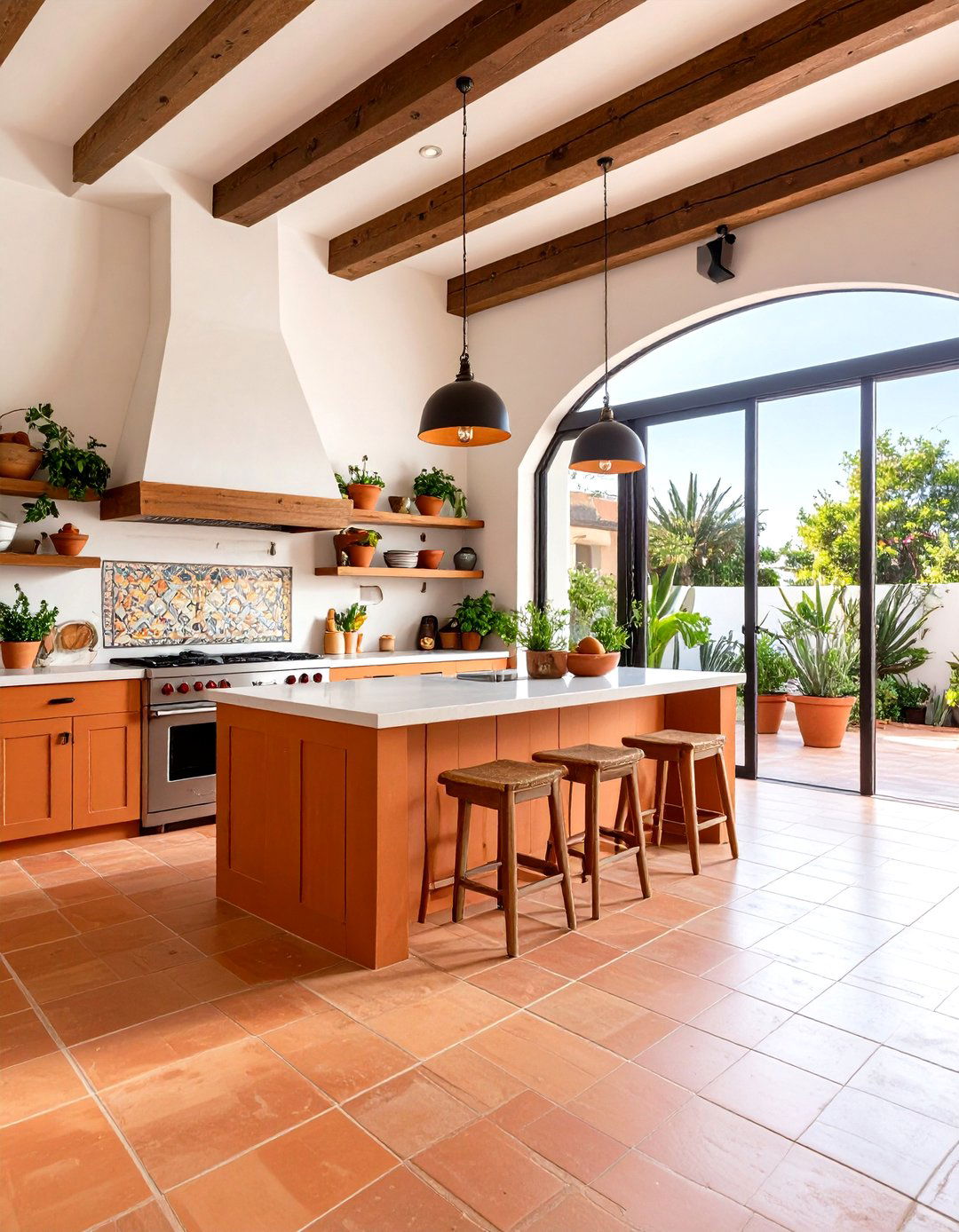
Inspired by traditional Mexican courtyards, this kitchen design emphasizes seamless flow between indoor and outdoor spaces using ornamental elements, terracotta paving tiles, and large windows. The layout incorporates multiple access points to outdoor areas, with folding glass doors that blur interior-exterior boundaries. Terracotta tiles extend from interior floors to outdoor patios, creating visual continuity, while ceiling fans and cross-ventilation systems take advantage of Mexico's favorable climate. Natural materials dominate, including exposed wooden beams and stone countertops that weather beautifully. Potted herbs and citrus trees in large ceramic planters bring the garden inside, while outdoor cooking areas extend the kitchen's functionality. This design celebrates the Mexican tradition of outdoor living and the importance of connecting with nature in daily life.
7. Vintage Mexican Kitchen with Pottery Display Features
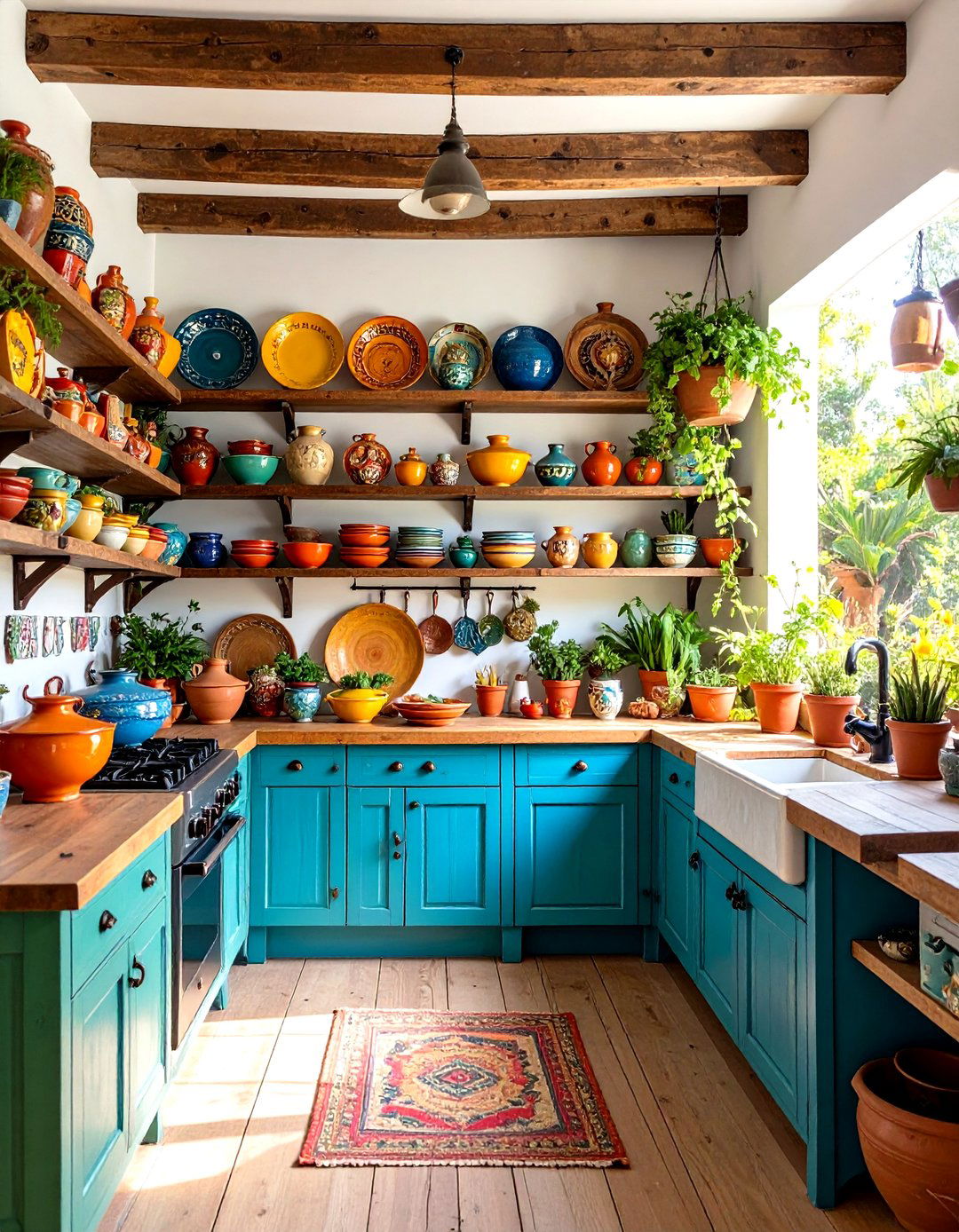
This nostalgic Mexican kitchen design celebrates the country's rich pottery traditions through extensive display opportunities and handmade Mexican pottery that has seen a 20% rise in U.S. sales as consumers seek authentic artisanal pieces. Open-air shelves replace closed cabinets, creating opportunities to showcase pottery collections and spice arrangements while maintaining accessibility. Vintage-inspired cabinetry in aged green or blue finishes provides backdrop for colorful ceramic displays, while traditional wooden shelving systems accommodate various pottery sizes. The design incorporates traditional Mexican furniture pieces like painted wooden chairs and rustic dining tables. Clay pots, ceramic plates, and traditional Mexican glassware become integral design elements rather than hidden storage items. This approach transforms functional kitchenware into decorative art, creating a lived-in atmosphere that honors Mexican craftsmanship traditions.
8. Mexican Kitchen with Copper Accent Design Elements
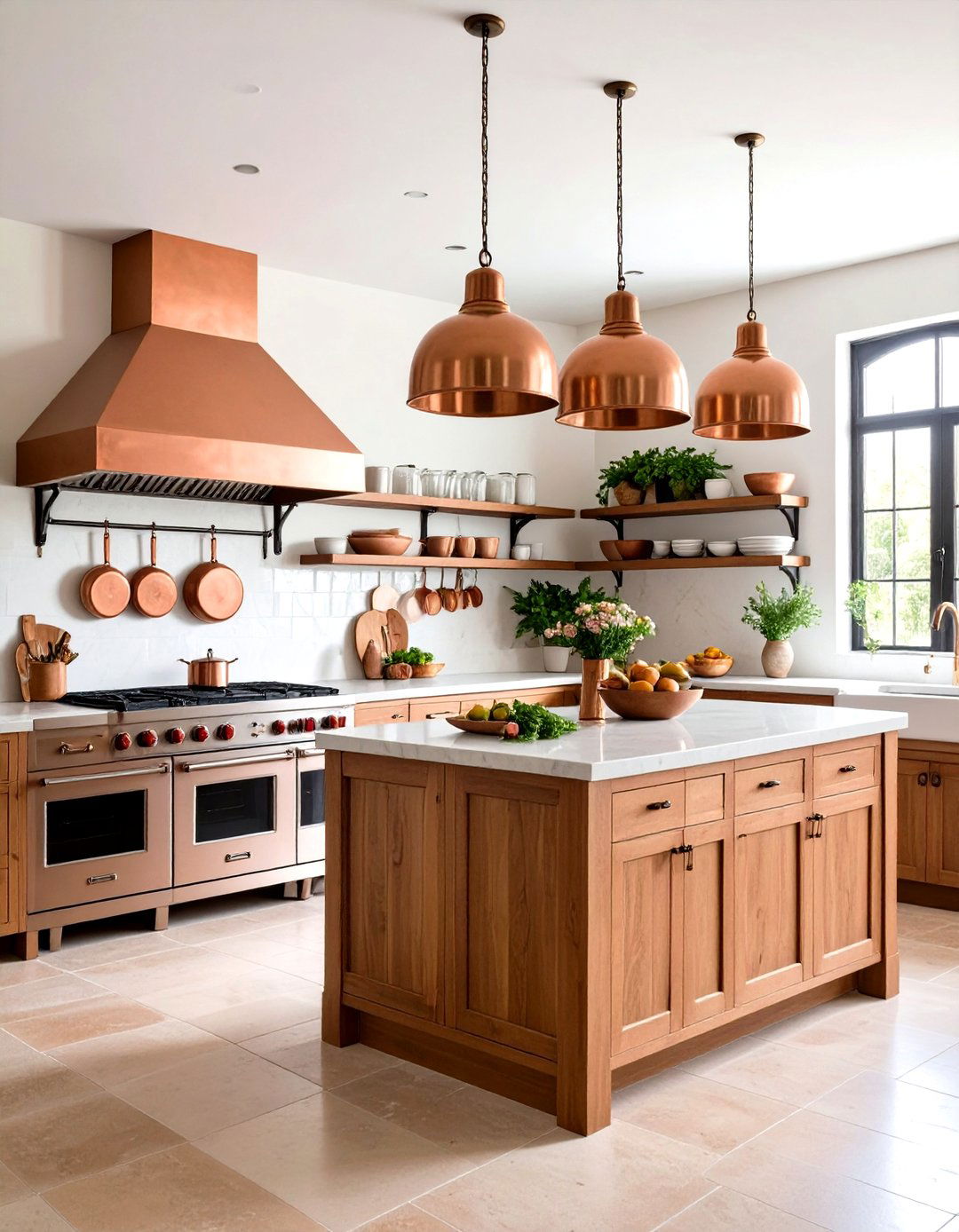
Copper accents define this warm Mexican kitchen style, incorporating copper range hoods, sinks, and cookware that add warmth and elegance to the overall design. Traditional copper pots and pans hang from wrought iron racks, serving both functional and decorative purposes. The design features copper backsplash sections that develop beautiful patina over time, complementing warm wood cabinetry and natural stone countertops. Copper vessel sinks and drop-in models gain momentum in bathroom and kitchen applications, bringing artisanal character to food preparation areas. Warm lighting fixtures in copper finishes create cohesive design flow, while copper accents in cabinet hardware and faucets provide subtle metallic touches. This approach celebrates Mexico's rich metalworking traditions while creating a kitchen that ages gracefully and develops character through use.
9. Southwestern Mexican Kitchen Fusion with Regional Elements
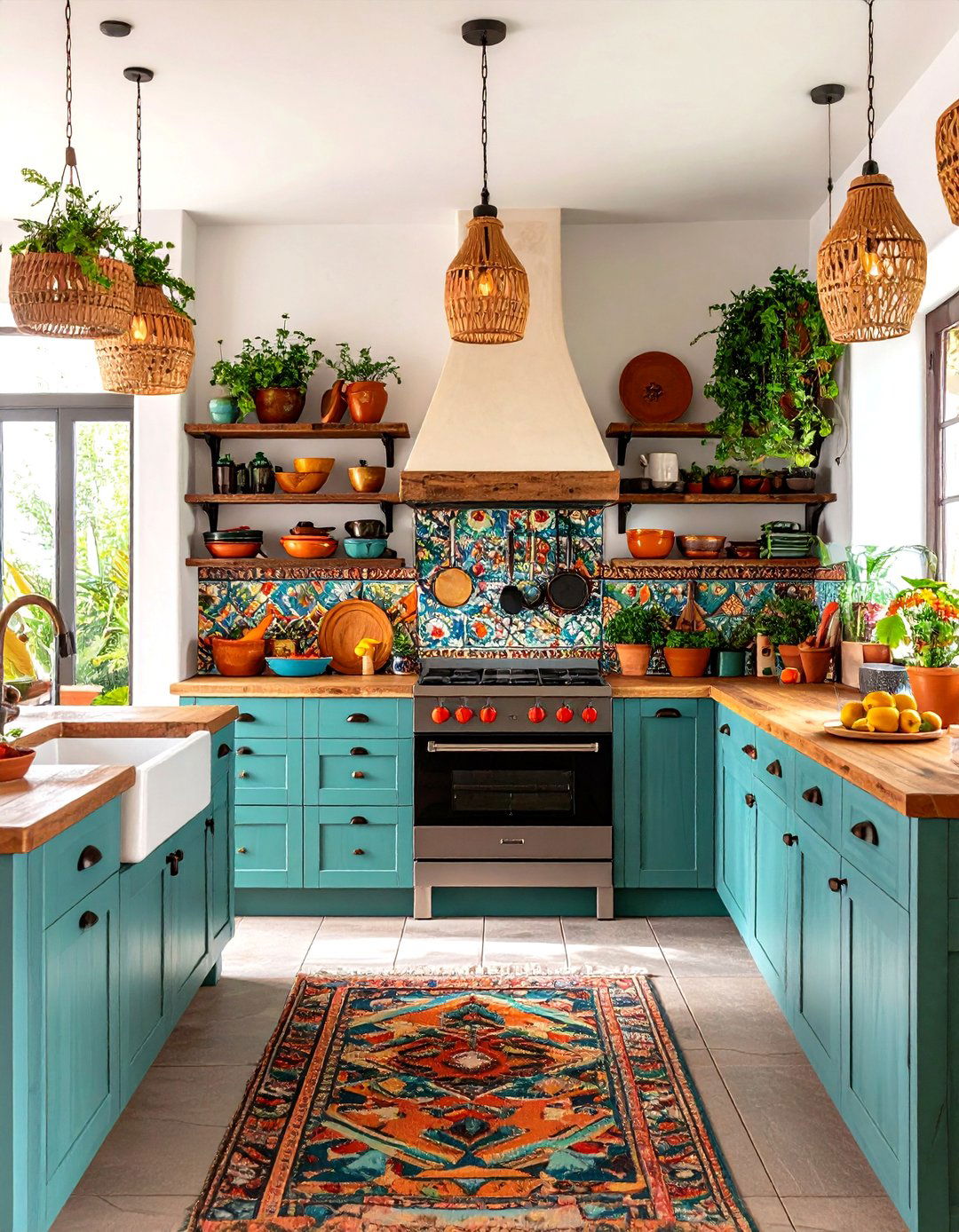
This fusion style combines Mexican traditions with Southwestern American influences, creating distinct looks that resonate well in western and southwestern United States regions. The design incorporates Native American patterns alongside Mexican motifs, using earth-tone ceramics and leather accents. Cabinetry features weathered wood finishes in sage greens and desert blues, while natural stone countertops reflect regional geology. Traditional Mexican elements like Talavera tiles blend with Pueblo pottery influences and Navajo textile patterns. The color palette draws from desert landscapes—terracotta, sage, sunset orange, and turquoise—creating harmony between Mexican warmth and Southwestern restraint. Rustic wooden beams and adobe-style wall finishes complete this regional fusion that honors both cultures while creating a uniquely American interpretation of Mexican kitchen design.
10. Mexican Kitchen with Exposed Beam Design Architecture
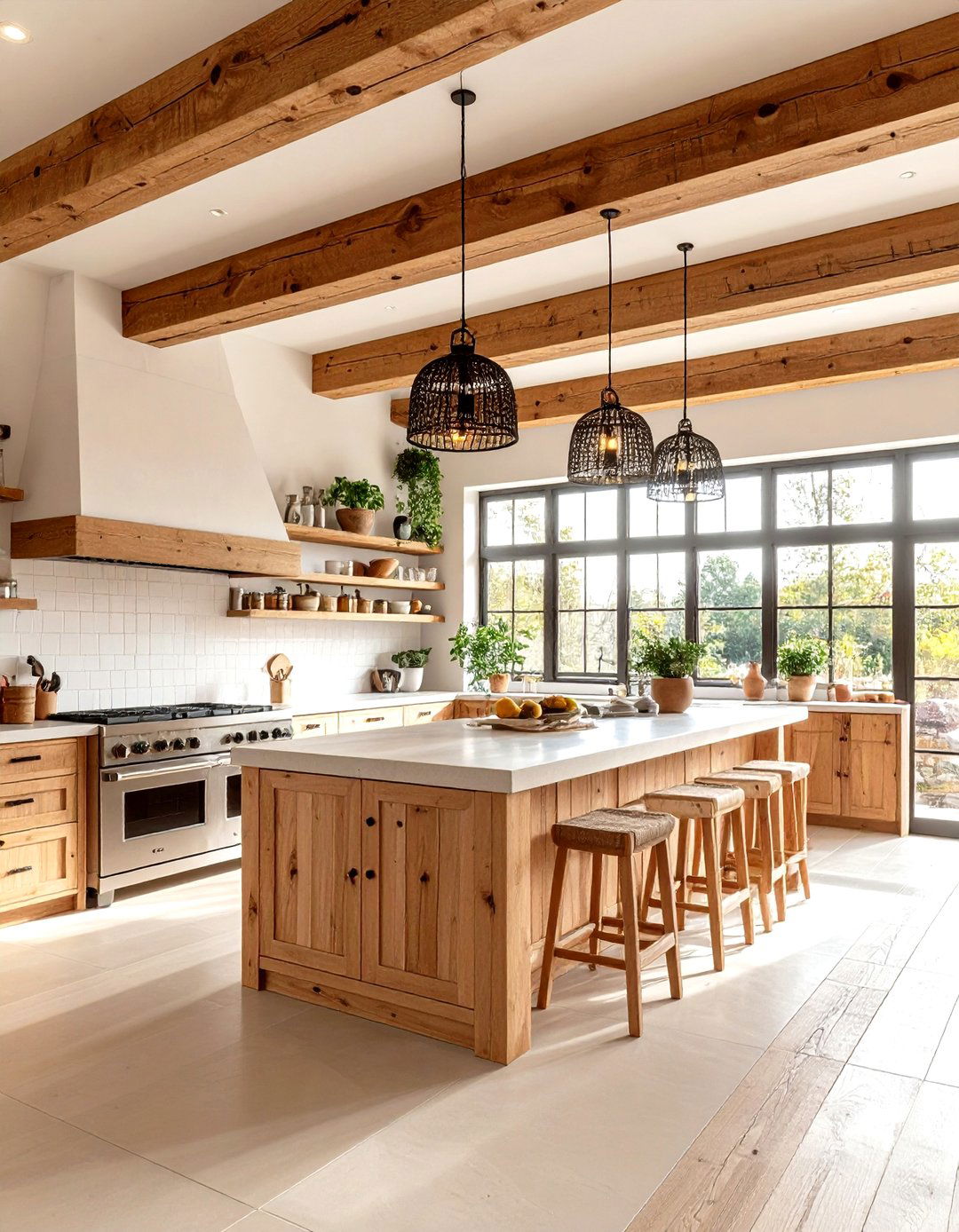
Exposed wooden beams serve as signature features of Mexican hacienda architectural style, exuding strength and stability while adding grandeur to kitchen spaces. This design showcases substantial ceiling beams in natural or dark-stained wood that complement rustic cabinetry and tile work below. The beams support traditional Mexican lighting fixtures like wrought iron chandeliers or ceramic pendant lights. Their time-worn appearance and natural texture infuse rustic charm that's difficult to replicate artificially. The supporting architecture includes thick walls with deep-set windows and substantial doorways that frame the beam structure. Modern kitchen functionality integrates seamlessly beneath these traditional architectural elements, while the beams provide natural divisions for different kitchen zones—cooking, preparation, and dining areas. This approach creates dramatic ceiling interest while honoring Mexico's architectural heritage.
11. Colorful Ceramic Mexican Kitchen with Artistic Elements
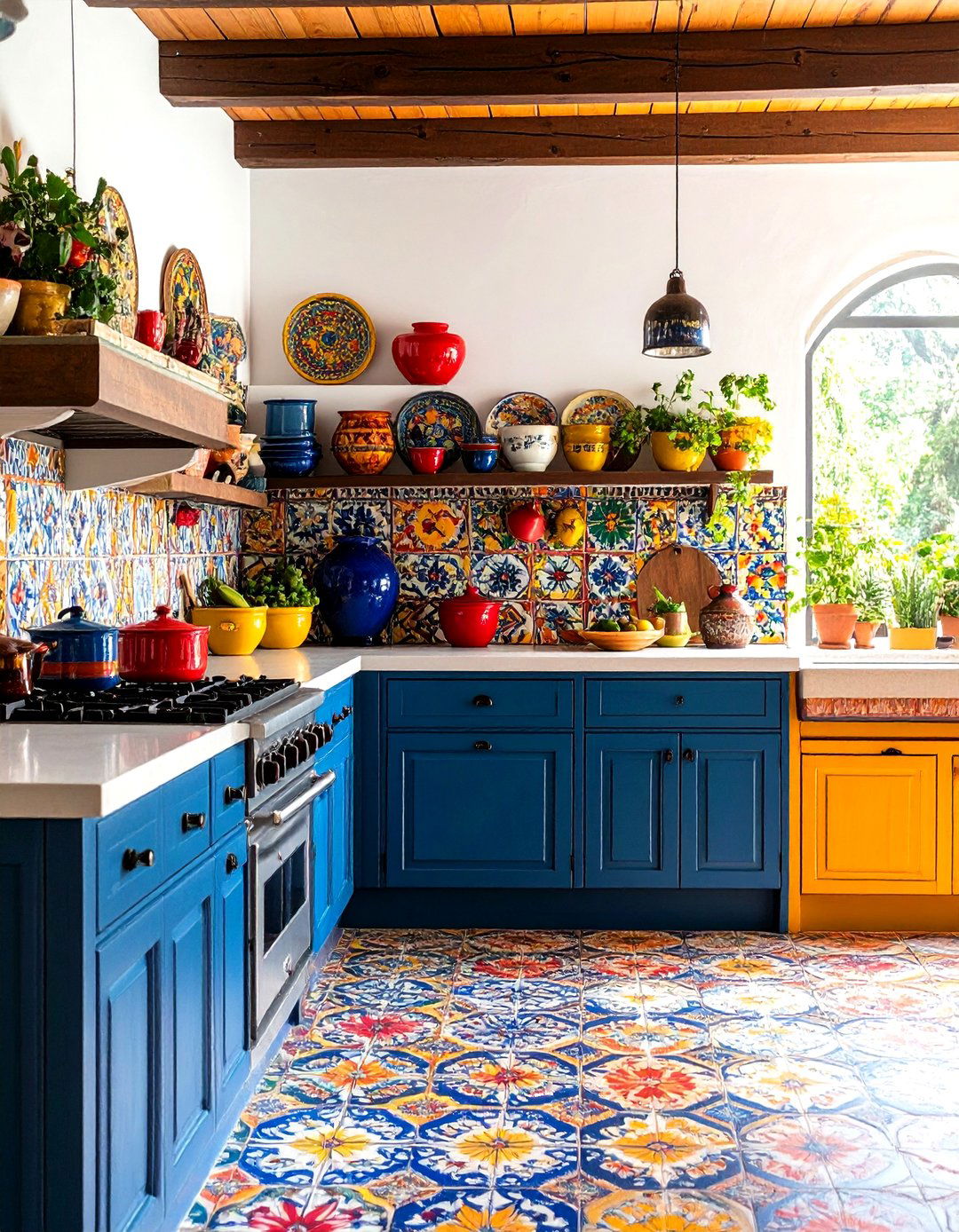
Vibrant ceramics form the centerpiece of this exuberant Mexican kitchen design, featuring hand-painted patterns in bold geometric designs and floral motifs that create eye-catching focal points. The backsplash showcases a mix-and-match approach to Talavera tiles, embracing both geometric designs and eclectic patterns to create cohesive yet varied visual interest. Colorful ceramic countertop sections alternate with practical work surfaces, while ceramic tile extends to kitchen islands and breakfast bars. Traditional Mexican pottery in blues, yellows, and reds fills open shelving and display niches. Weekend DIY projects can incorporate ceramic elements like breakfast bars using cobalt blue and ochre tiles. This approach treats the kitchen as an art gallery where functional ceramics become sculptural elements, creating daily joy through color and pattern while maintaining full functionality.
12. Adobe-Style Mexican Kitchen with Textured Walls
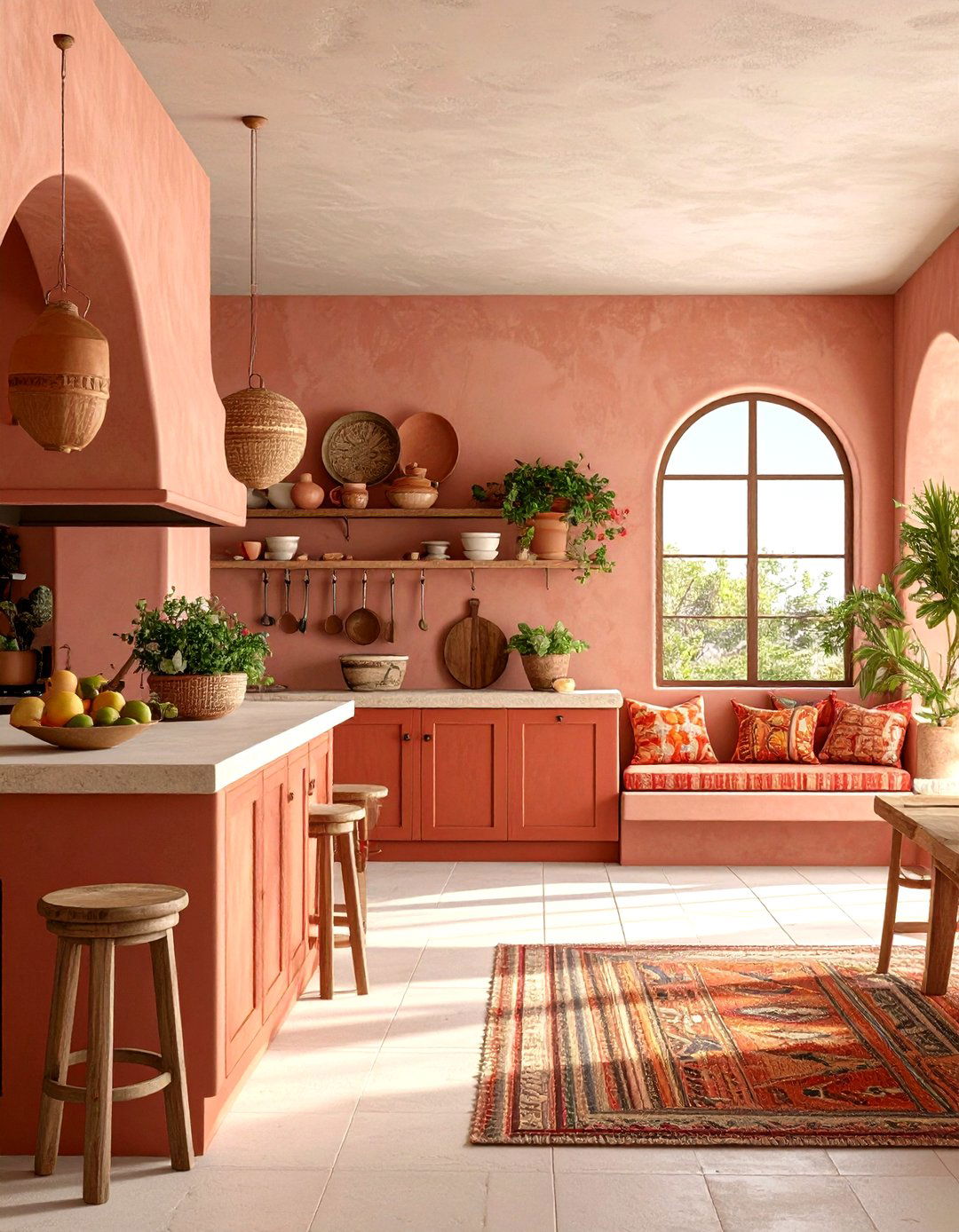
Adobe or textured plaster walls create the traditional look of Mexican hacienda architecture, providing neutral yet textured backdrops for kitchen design. This style features thick walls with rounded corners and deep-set windows that create interesting shadows and architectural depth. The textured surfaces complement smooth ceramic tiles and polished countertops, creating material contrast throughout the space. Natural pigments in the plaster provide subtle color variations that change with lighting throughout the day. Traditional Mexican furniture pieces like painted wooden chairs and rustic tables gain prominence against these simple wall treatments. The design incorporates built-in banquettes with cushioned seating in Mexican textiles, creating intimate dining nooks. This approach emphasizes the handcrafted quality of traditional Mexican construction while providing a sophisticated backdrop for both traditional and contemporary kitchen elements.
13. Mexican Kitchen with Wrought Iron Feature Details
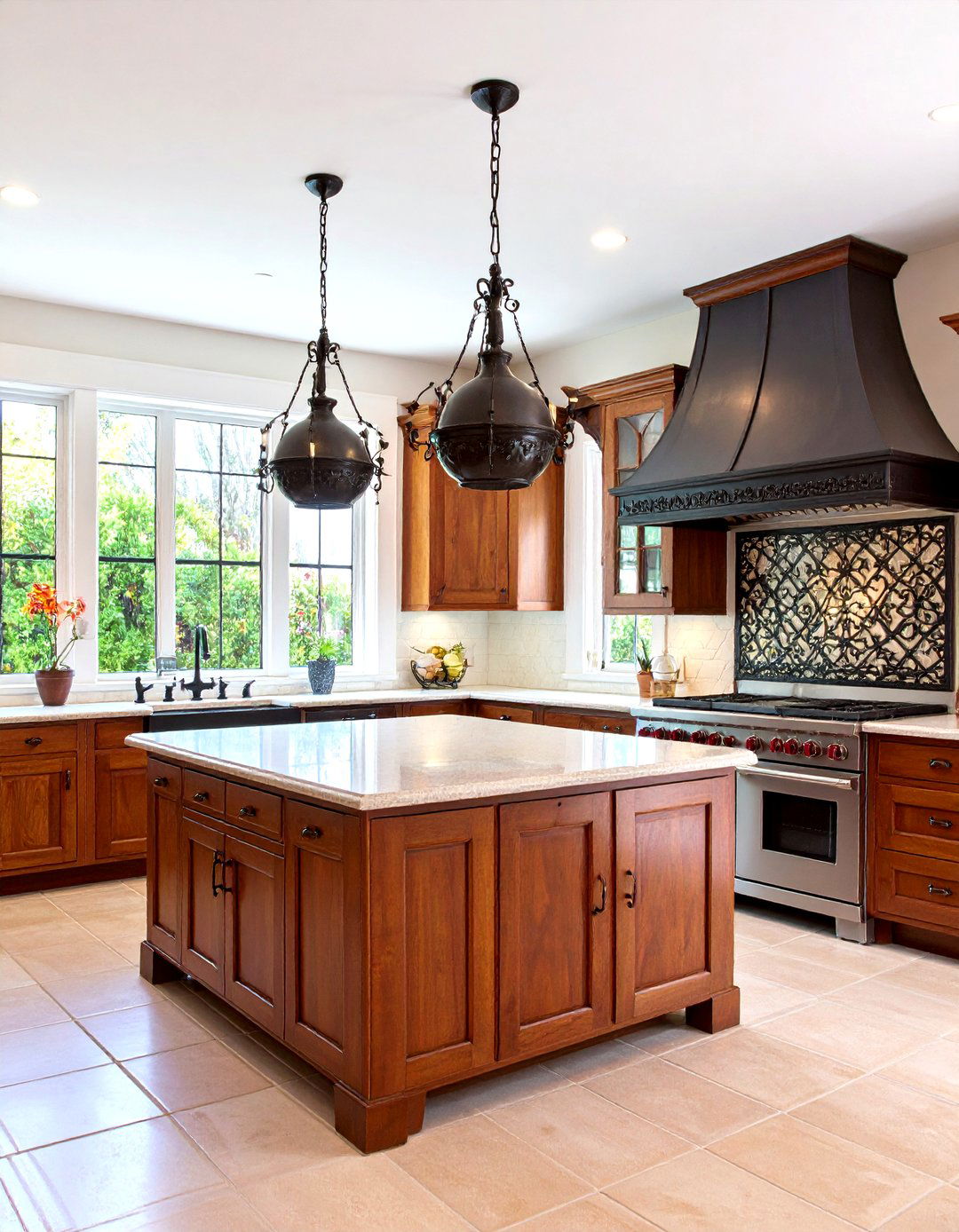
Wrought iron has been integral to Mexican design for centuries, dating back to the colonial era and creating beautiful contrasts to rustic and colorful kitchen elements. This design showcases ornate iron work in light fixtures, pot racks, and cabinet hardware that adds elegance alongside tradition. Hand-forged iron details appear in window grilles, range hoods, and decorative wall elements that create dramatic focal points. Lighting fixtures feature wrought iron chandeliers or pendants with ornate designs carrying styles from Gothic, East Indies, or Mexican-Aztec traditions. The ironwork complements both rustic wooden elements and colorful tile work, providing sophisticated contrast to softer materials. Traditional Mexican furniture pieces feature iron accents and hardware that coordinate with larger architectural elements. This approach celebrates Mexico's metalworking heritage while adding structural elegance to contemporary kitchen functionality.
14. Terracotta and Earth-Tone Mexican Kitchen Design
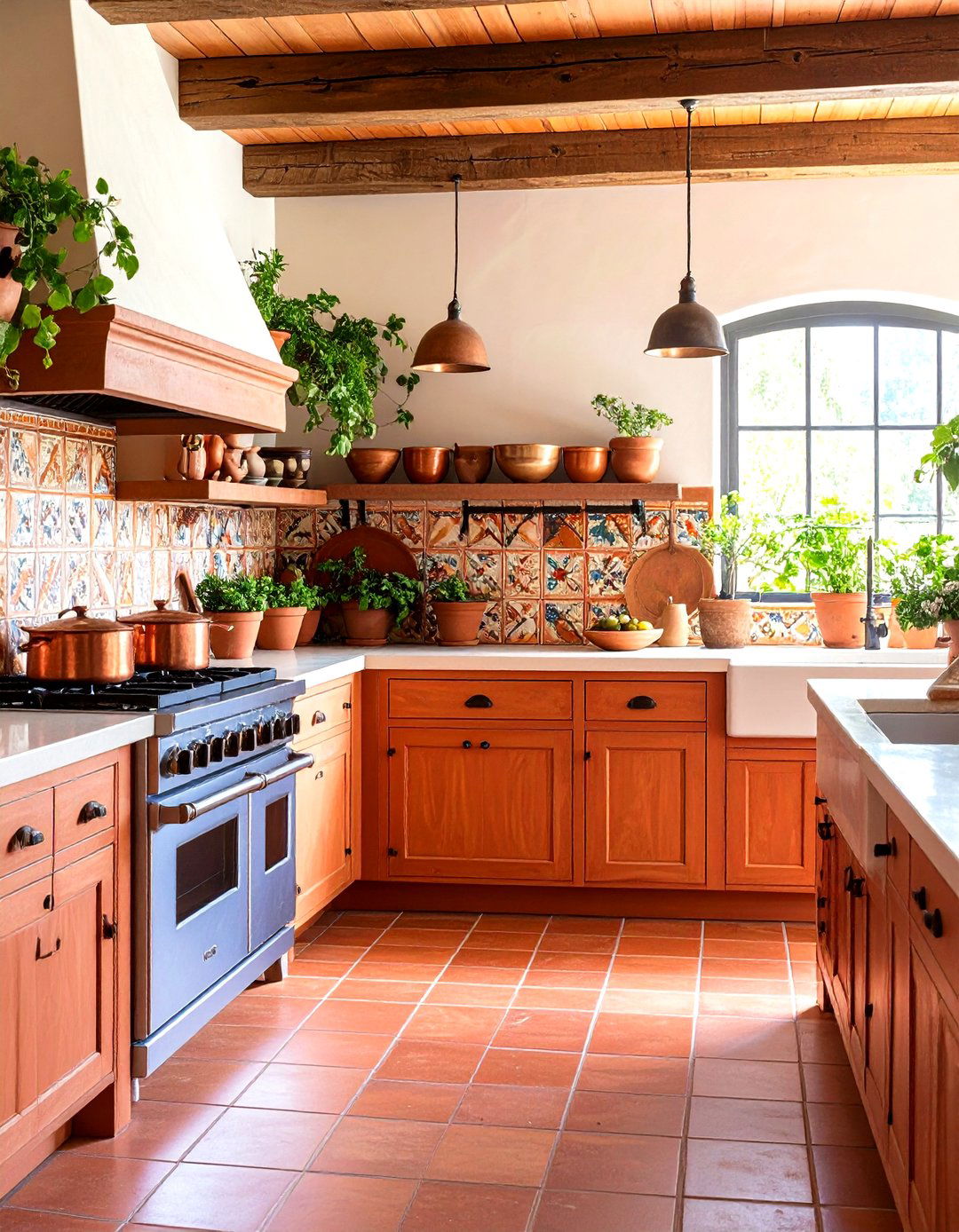
Earth tones create the foundation for this naturalistic Mexican kitchen that emphasizes terracotta tiles, Saltillo tiles, and natural stone flooring to maintain earthy, traditional aesthetics. The color palette draws from Mexico's landscape—clay reds, sandy beiges, warm browns, and sunset oranges. Cabinetry features natural wood finishes that complement terracotta tile backsplashes and countertop accents. Saltillo terracotta flooring provides rich, earthy foundation colors with impressive versatility that complements various accent tiles. Traditional pottery in earth tones fills display areas, while copper accents add warm metallic contrast. Natural fiber textiles in woven patterns provide softness against hard surfaces. This approach creates harmony with Mexico's natural environment while establishing a calming, grounded atmosphere that feels both sophisticated and authentically rooted in traditional materials.
15. Mexican Kitchen with Hand-Painted Mural Design Features
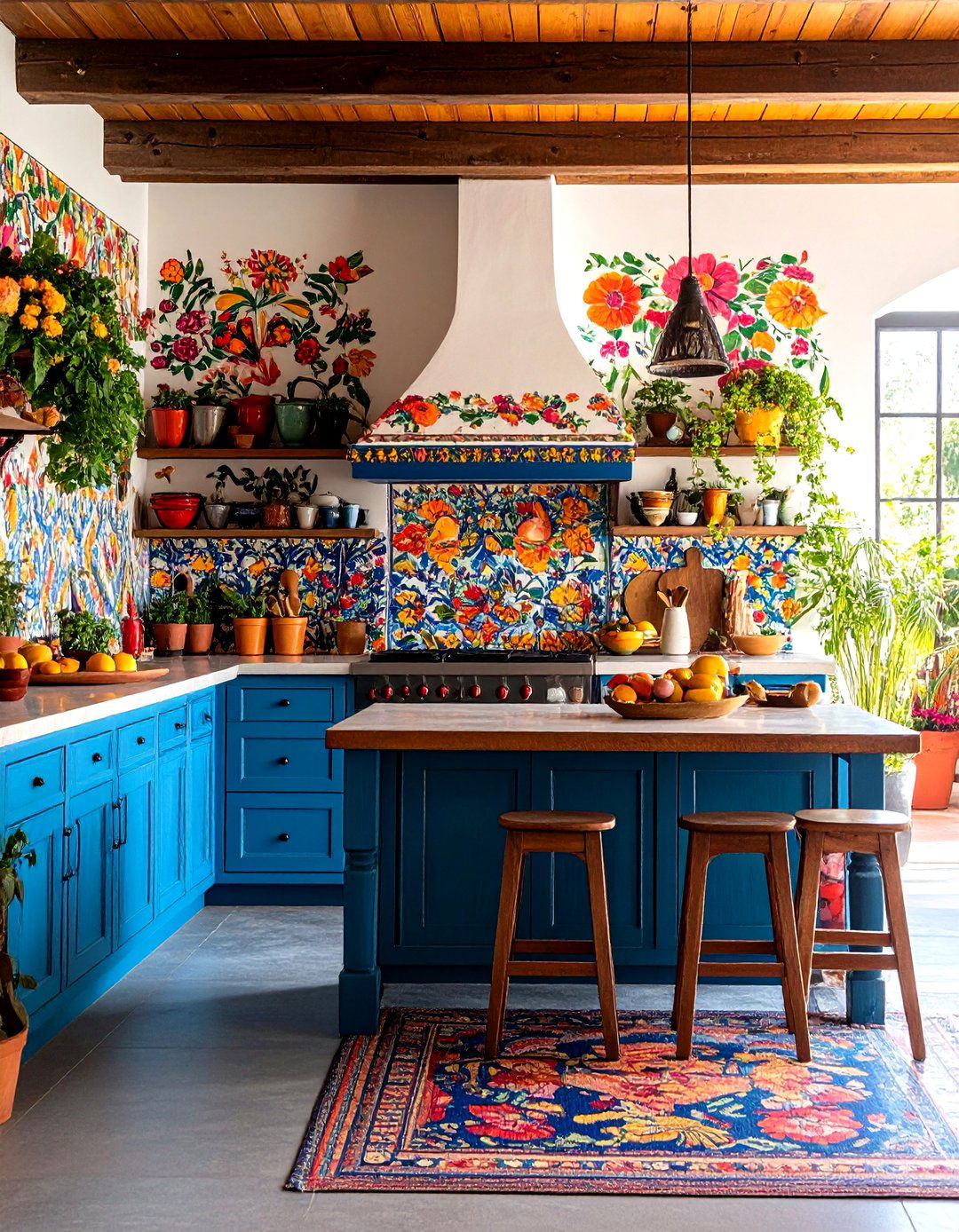
Artistic expression takes center stage in this Mexican kitchen featuring hand-painted murals that celebrate Mexican heritage through wall art and decorative painting. Traditional Mexican motifs like Day of the Dead imagery, floral patterns, and cultural symbols adorn accent walls and cabinet surfaces. Dia de los Muertos imagery and associated artwork make their way into kitchen design as important cultural elements. The murals complement rather than compete with functional elements, appearing in strategic locations like above stoves or in dining areas. Professional artists or skilled homeowners can create these custom elements that tell personal or cultural stories. The painting extends to furniture pieces like kitchen islands and breakfast tables, creating cohesive artistic themes. This approach transforms the kitchen into a cultural celebration space where daily activities occur within an artistic environment that honors Mexican traditions and personal expression.
16. Spanish Colonial Mexican Kitchen with Historical Elements
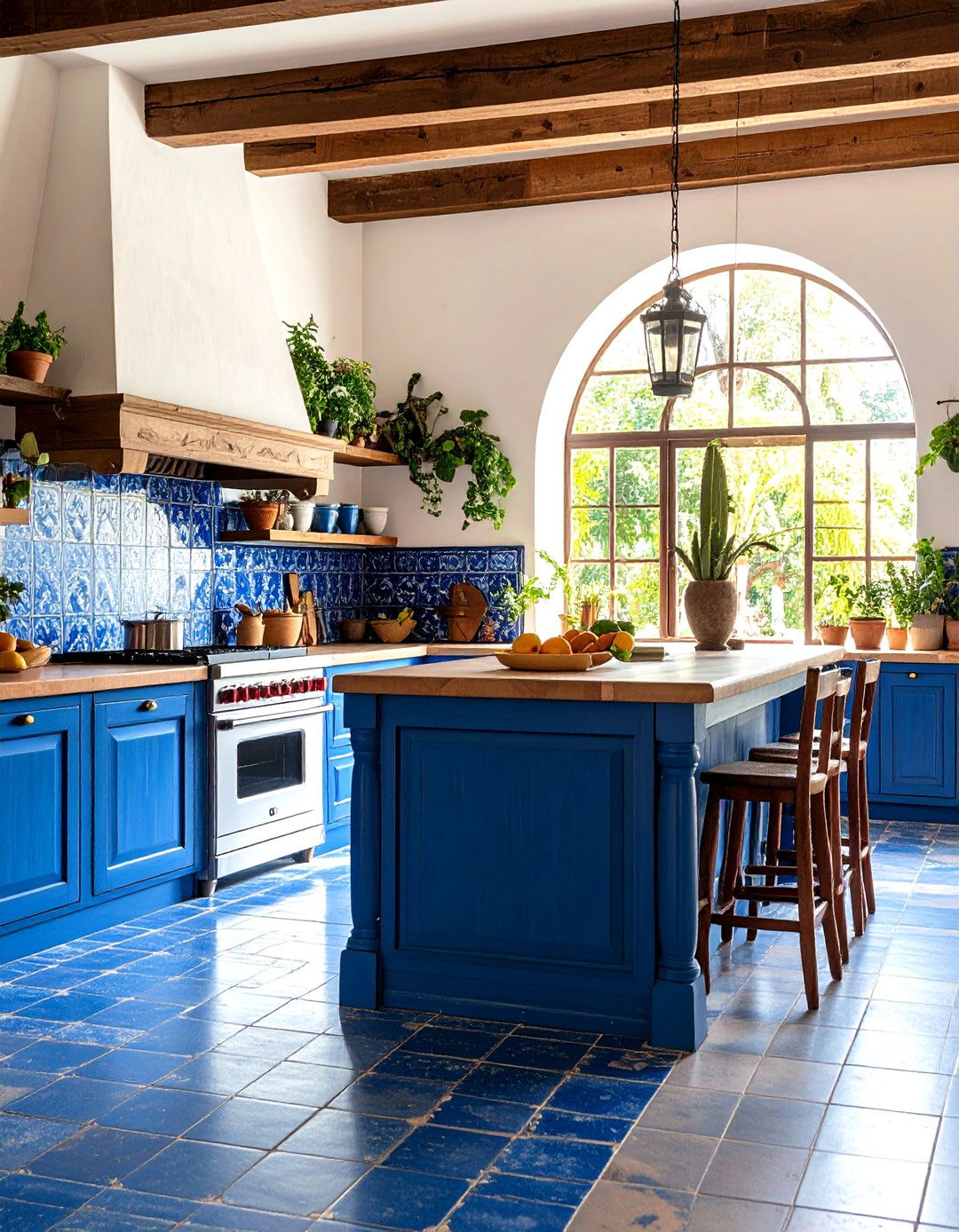
This sophisticated style draws from Mexico's colonial period, incorporating influences from cavernous colonial convent kitchens with vaulted ceilings and extensive tile work. The design features formal architectural elements like arched doorways, carved wooden details, and substantial masonry construction. Traditional deep cobalt blue tiles reference the expensive pigments used in colonial-era wealthy households, while hand-carved wooden furniture displays Spanish Colonial craftsmanship. The layout emphasizes grand scale with high ceilings, substantial cooking areas, and formal dining spaces that reflect colonial hacienda grandeur. Religious and cultural artifacts find appropriate display locations, while traditional materials like stone, wood, and iron create authentic historical atmosphere. Modern appliances integrate discretely within period-appropriate cabinetry, maintaining historical integrity while providing contemporary functionality for today's cooking needs.
17. Mexican Kitchen with Open Shelving Display System
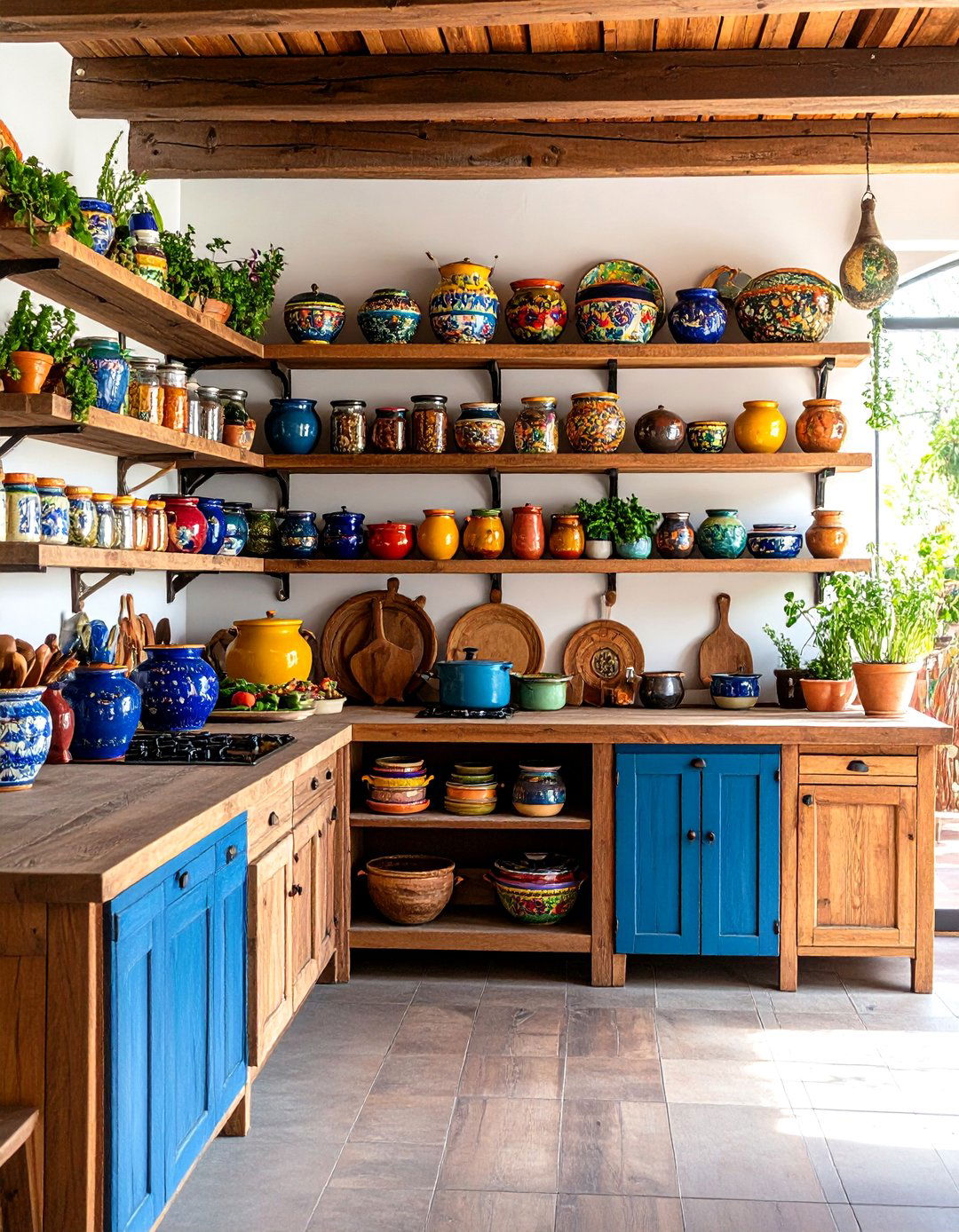
Open-air shelving replaces traditional closed cabinets, creating storage that doubles as decorative display while maintaining easy access to kitchen essentials. This design philosophy embraces the Mexican tradition of displaying beautiful functional objects rather than hiding them away. Wooden shelving systems showcase colorful Mexican pottery, spice collections in glass jars, and traditional cookware. Open shelving allows for stunning displays of Mexican ceramics collections, letting the artistry of each piece speak for itself. The approach requires thoughtful organization and selection of display items that coordinate with overall design themes. Traditional Mexican furniture pieces like painted wooden cupboards provide some concealed storage while maintaining open display principles. This style celebrates the Mexican philosophy of integrating beauty into daily life, where functional objects become decorative elements that create visual interest throughout the kitchen space.
18. Mexican Kitchen with Saltillo Tile Floor Design
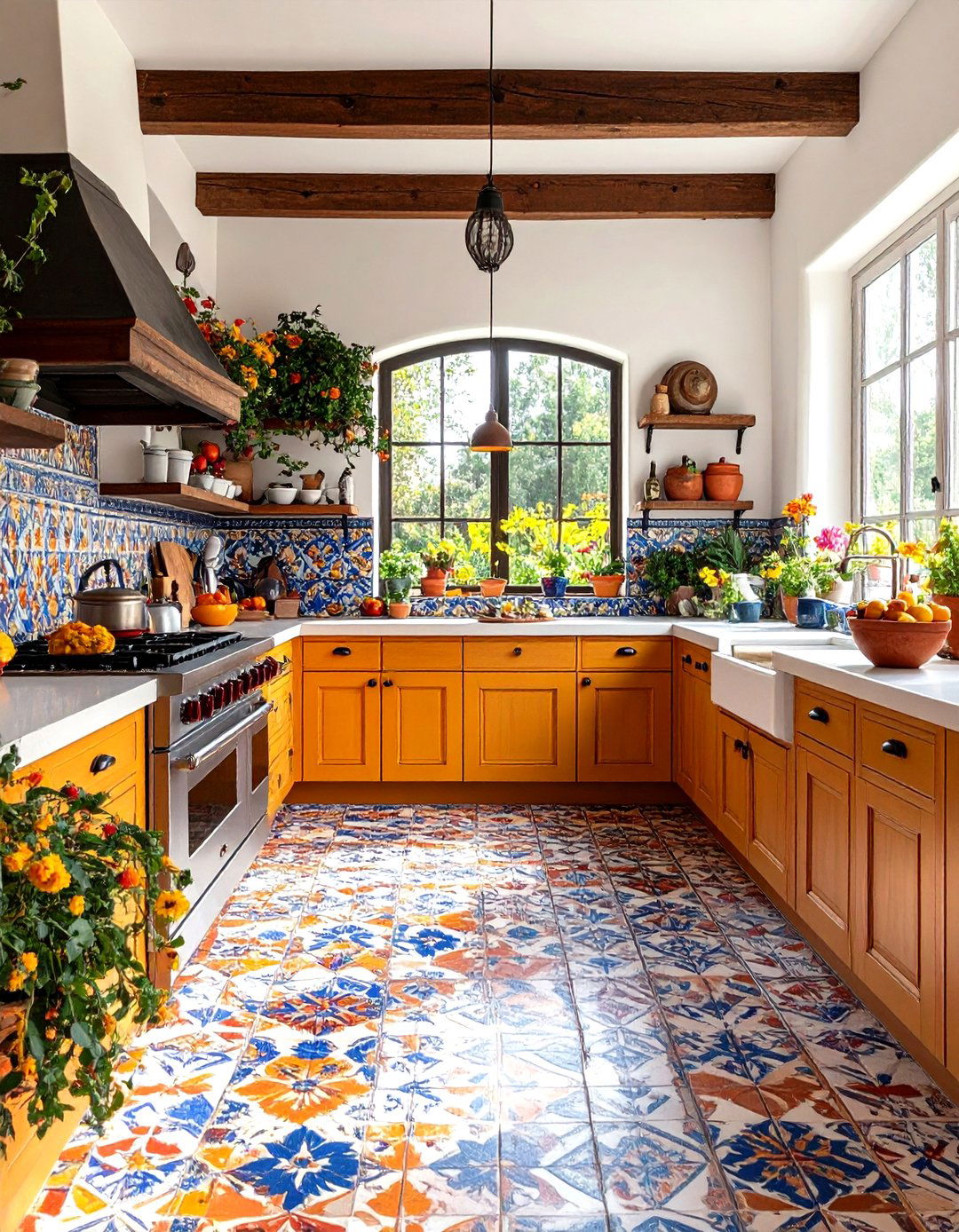
Saltillo tiles serve as the foundation for Mexican kitchen design, beloved for their rich, earthy colors, historical artistry, and impressive versatility. These handcrafted clay tiles provide warm, natural flooring that develops beautiful patina through use while maintaining durability for high-traffic kitchen areas. The irregular surface textures and color variations create authentic handmade character that complements both traditional and contemporary Mexican design elements. Saltillo terracotta flooring particularly complements artisan-style backsplashes and mixed Mexican tile patterns. The tiles extend seamlessly from interior kitchen spaces to adjoining outdoor areas, creating visual flow between indoor and outdoor cooking zones. Traditional Mexican area rugs in geometric patterns can define specific zones while protecting high-wear areas. This flooring choice establishes an authentic foundation that influences all other design decisions while providing practical, long-lasting surface that improves with age.
19. Mexican Kitchen with Arched Architectural Detail Features
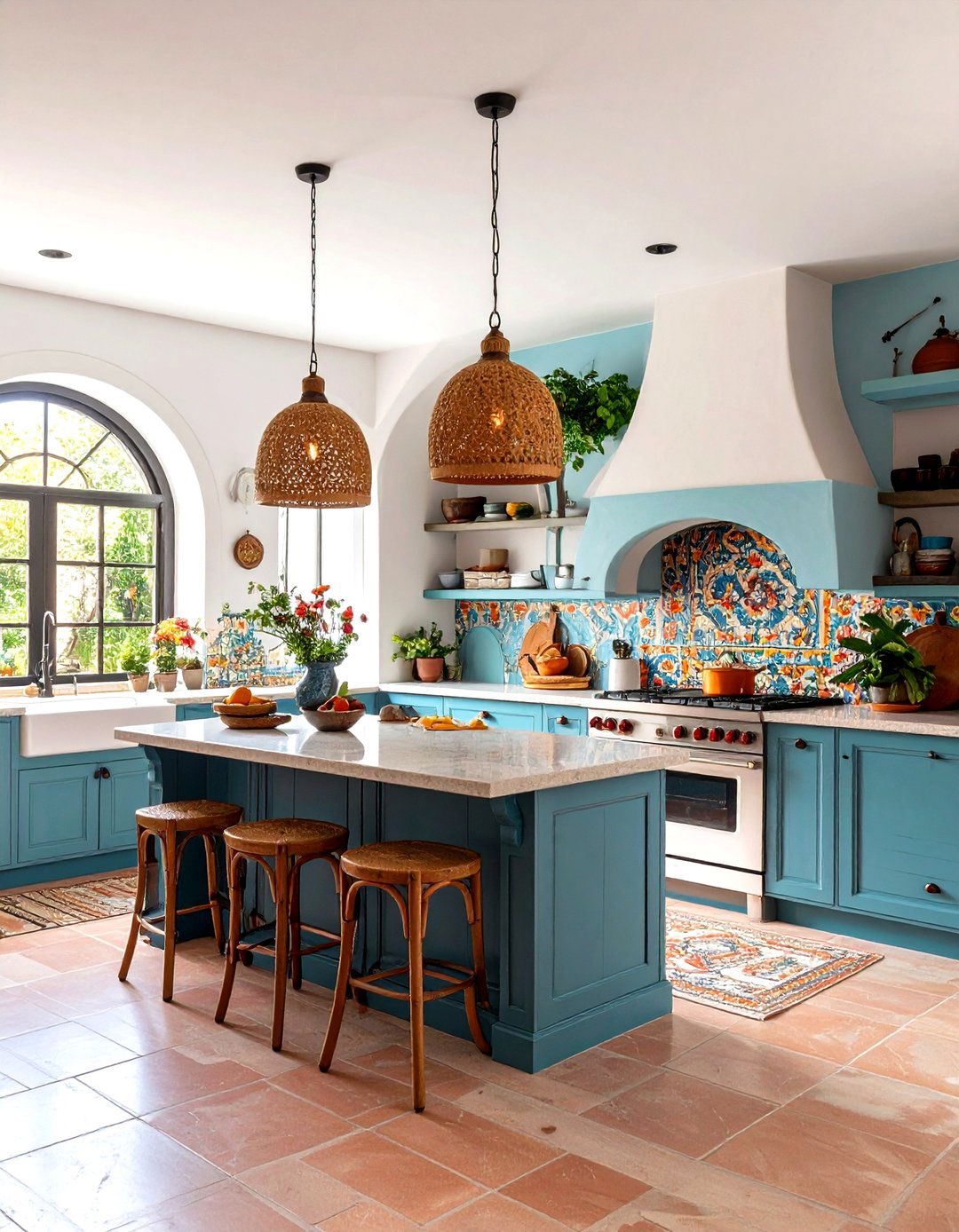
Arched doorways, alcoves, and niches represent hallmark architectural elements of hacienda-style Mexican homes that create dramatic visual interest in kitchen design. This approach incorporates curved architectural elements throughout the space—from doorway openings to built-in storage niches and decorative alcoves. Rounded arches at cabinet and stove levels replace typical rectangular forms, creating softer, more organic spatial flow. Traditional storage arches, originally used for firewood in hacienda kitchens, now house modern appliances or display Mexican pottery collections. The curved elements soften hard lines of contemporary appliances while creating intimate spatial divisions within larger kitchen areas. Stone or tile work emphasizes arch details through contrasting materials and colors. This architectural approach creates sophisticated spatial rhythm while honoring traditional Mexican construction methods that emphasized curves over rigid geometric forms.
20. Mexican Kitchen with Indoor Herb Garden Design Integration
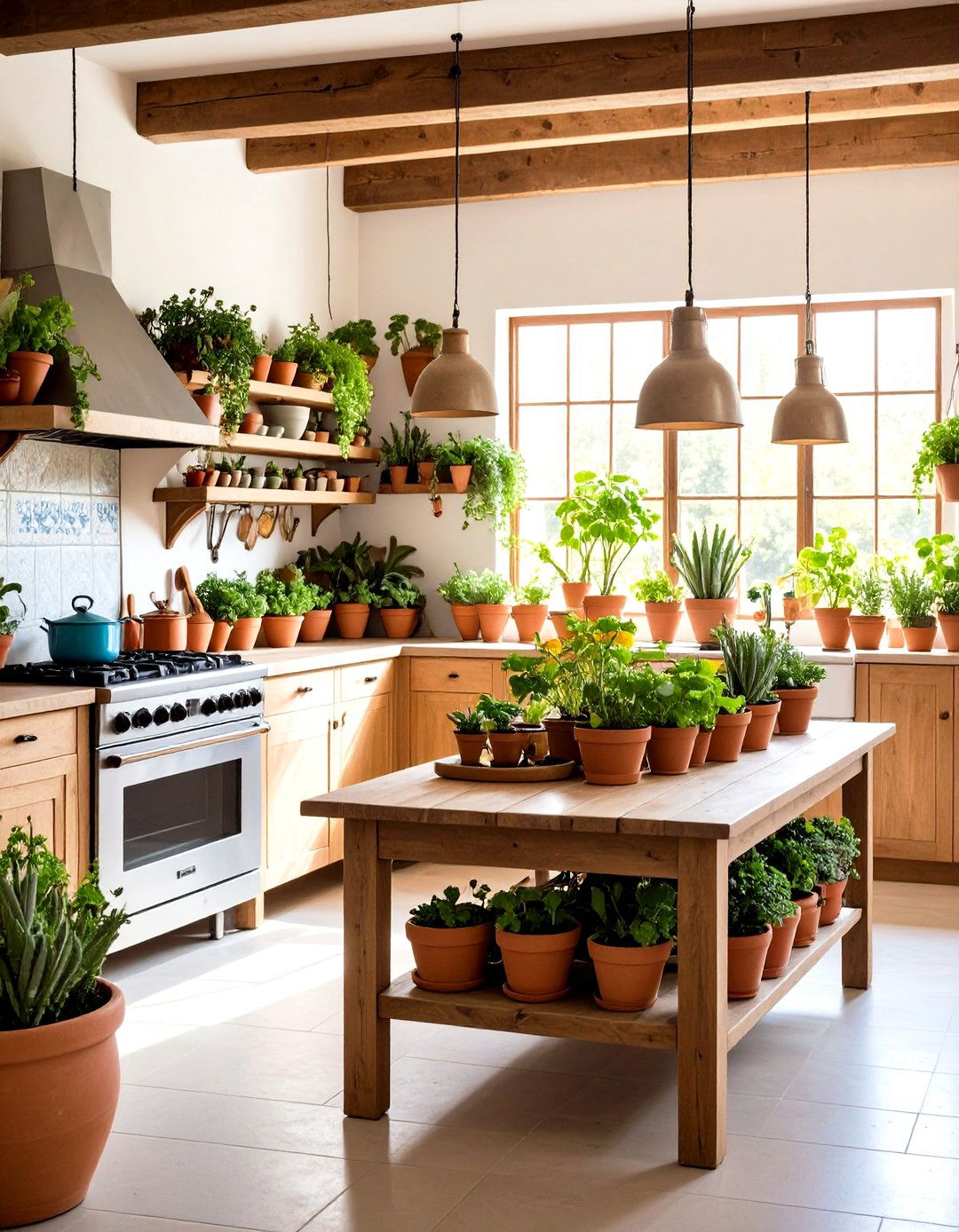
Indoor herb gardens add practical functionality while reflecting the use of fresh ingredients common in Mexican cooking traditions. This design incorporates growing areas throughout the kitchen using traditional terracotta pots, hanging planters, and built-in growing systems. Potted plants like succulents and herbs bring life and freshness while complementing earthy Mexican design tones. Window herb gardens maximize natural light while providing easy access during cooking, while larger floor planters can accommodate citrus trees or substantial herb collections. Traditional Mexican pottery serves dual purposes as planters and decorative elements, creating cohesive design flow. The integration emphasizes Mexico's connection to agriculture and fresh ingredients while providing practical benefits for daily cooking. This approach celebrates the Mexican tradition of incorporating nature into living spaces while supporting the fresh, flavorful cooking that defines Mexican cuisine.
Conclusion:
Mexican kitchen design offers a rich tapestry of possibilities that blend cultural heritage with contemporary functionality. From traditional hacienda grandeur featuring exposed beams and Talavera tiles to modern interpretations emphasizing clean lines and bold colors, these spaces celebrate Mexico's artistic traditions while meeting today's lifestyle needs. Whether incorporating authentic materials like Saltillo tiles and wrought iron details or embracing contemporary fusion approaches, Mexican kitchens create warm, inviting environments that honor the importance of cooking and gathering in Mexican culture while providing practical, beautiful spaces for modern living.


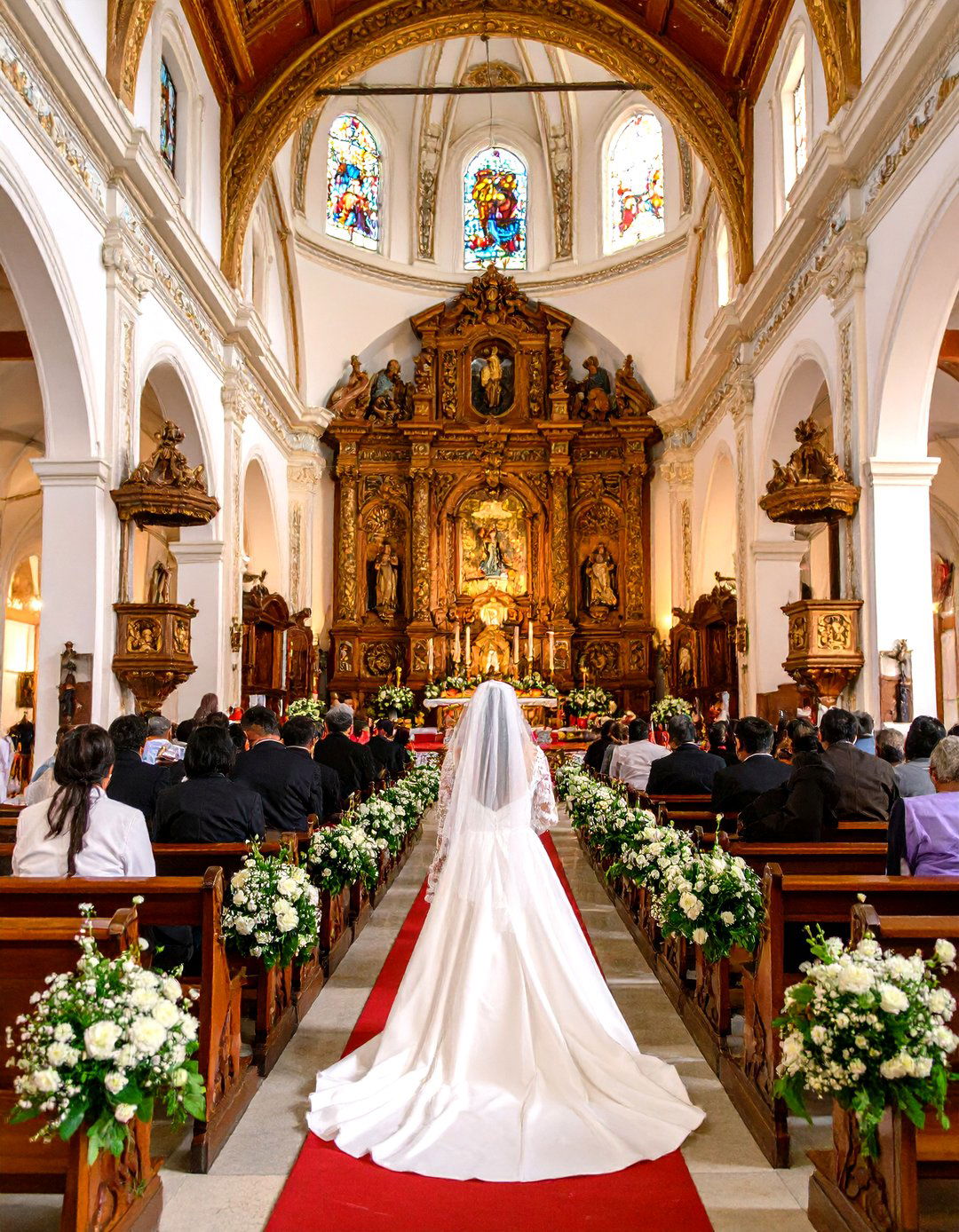
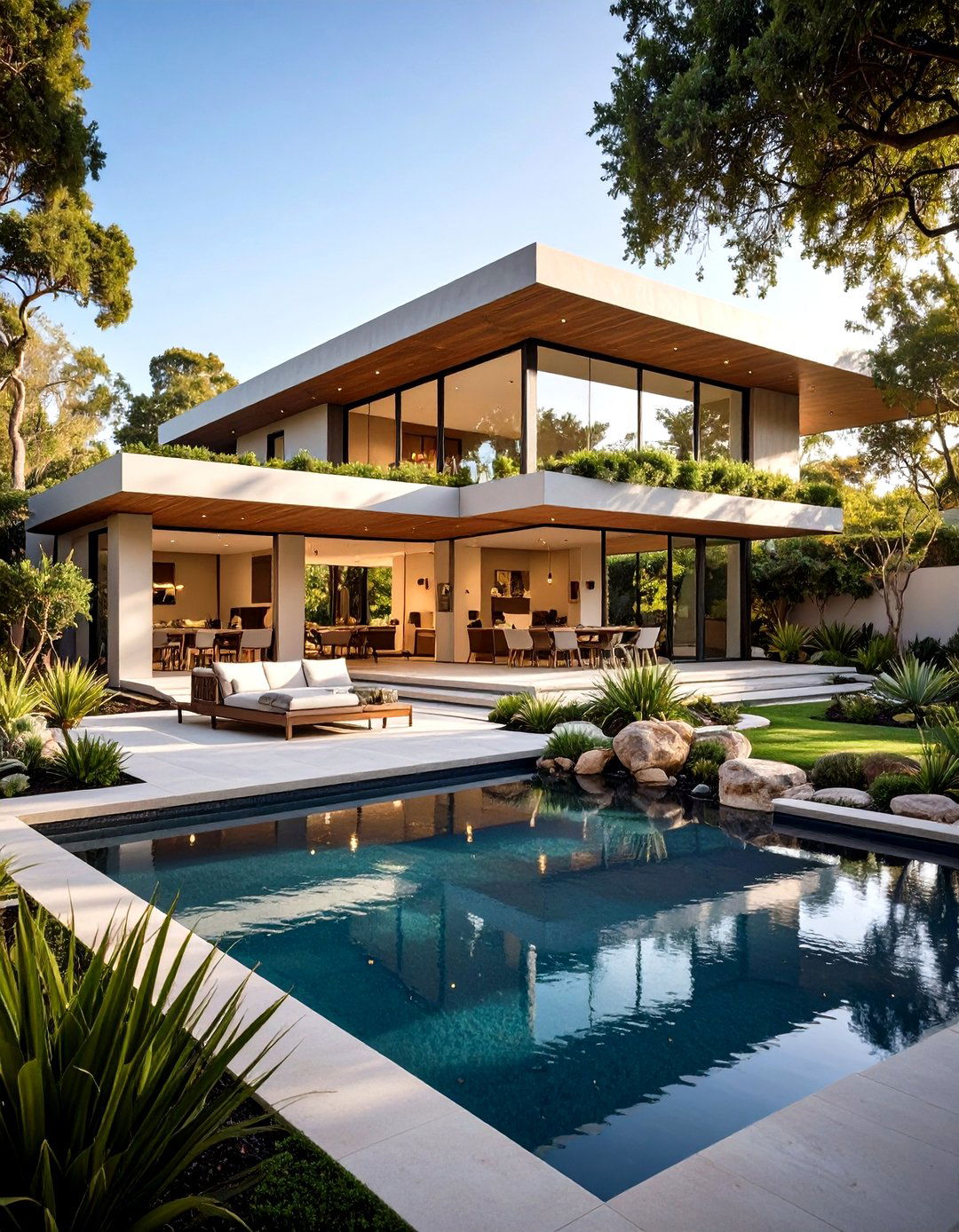
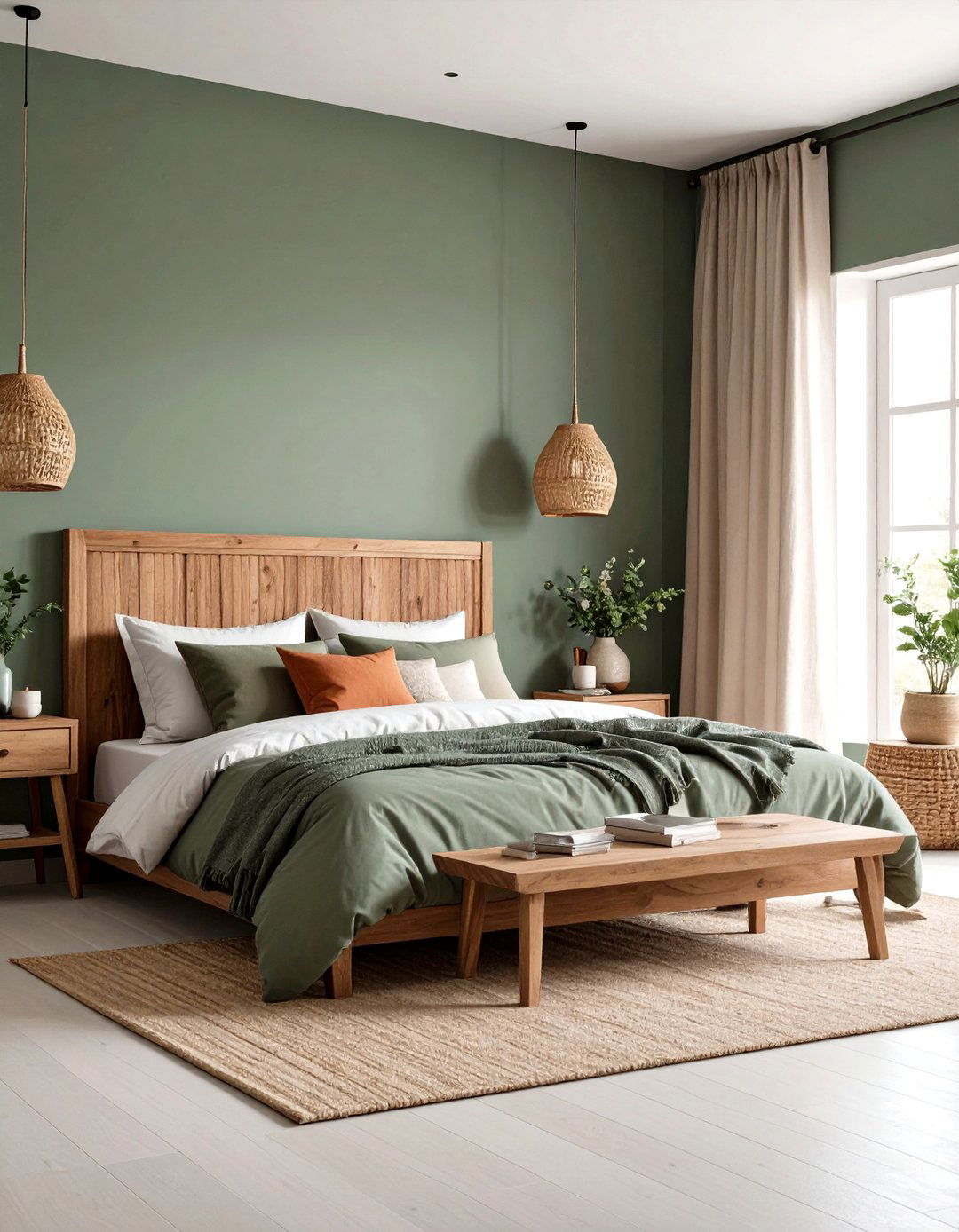
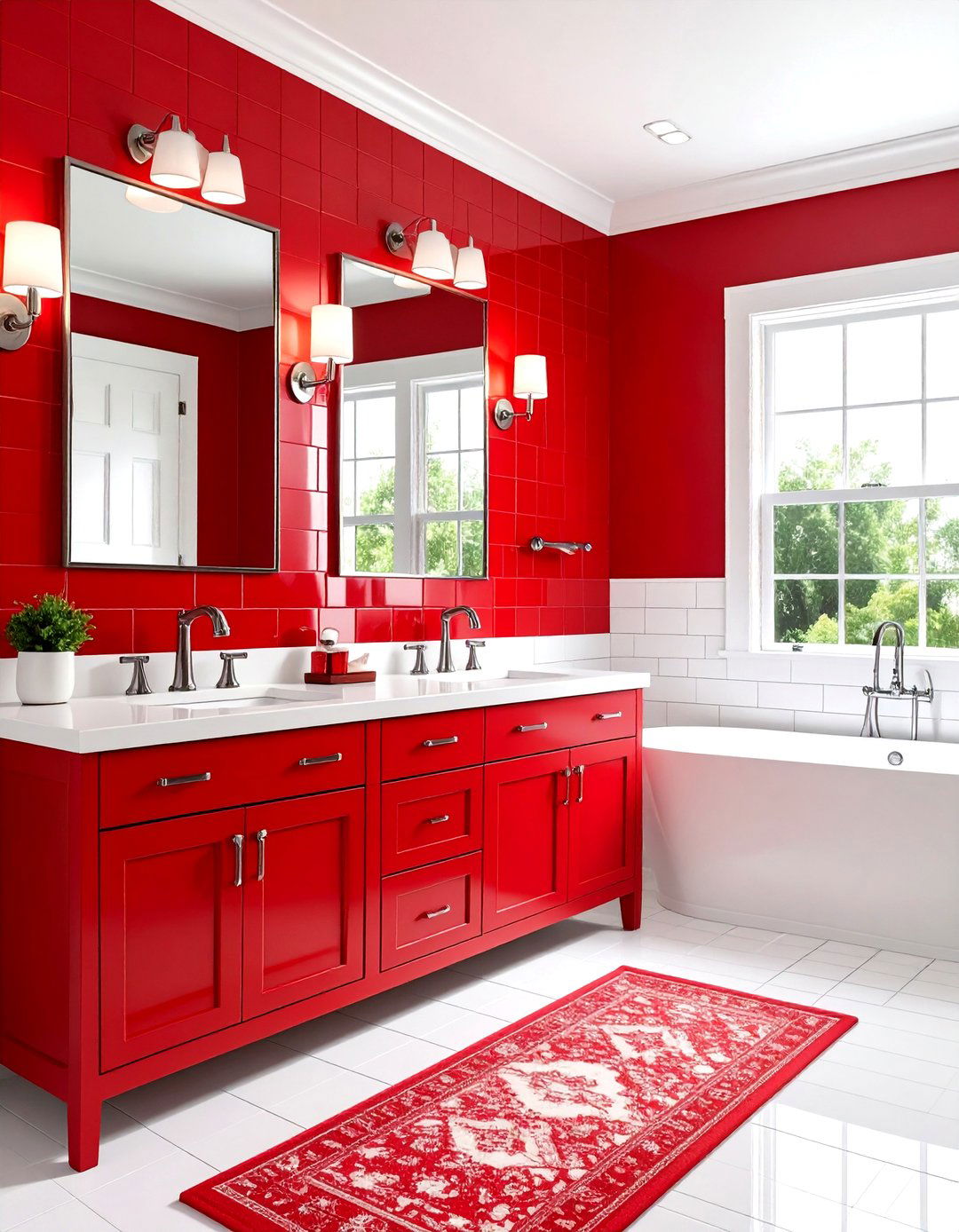
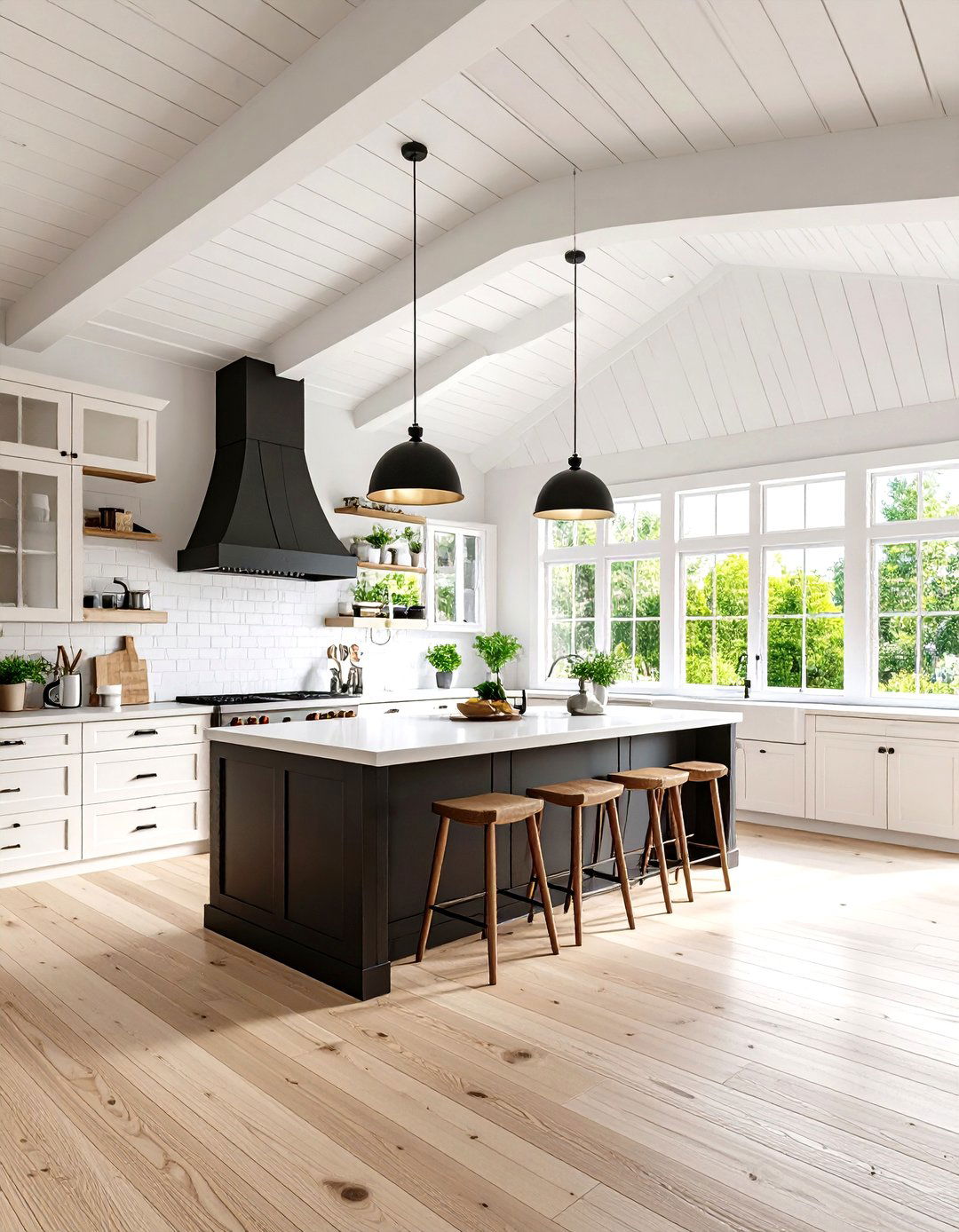

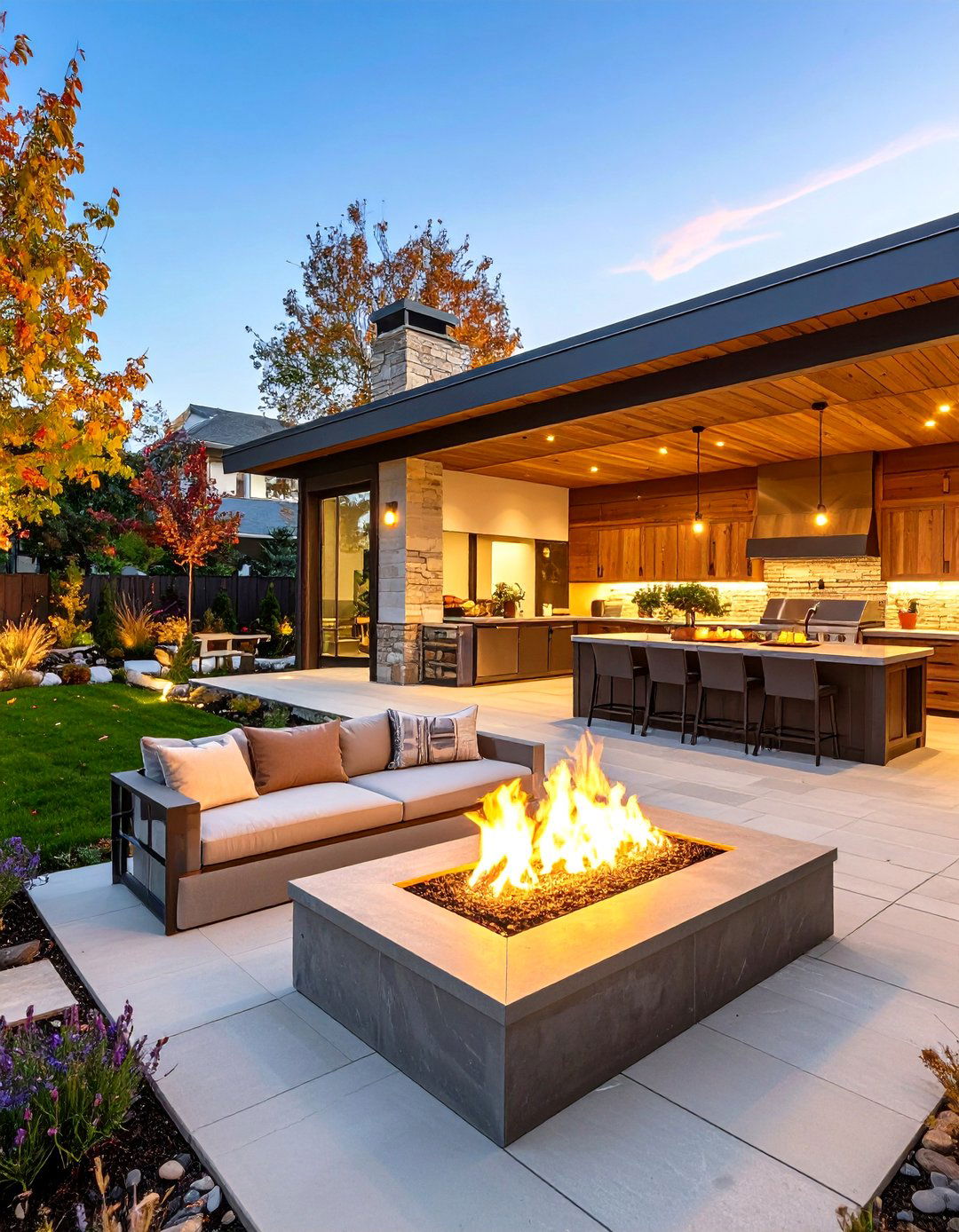
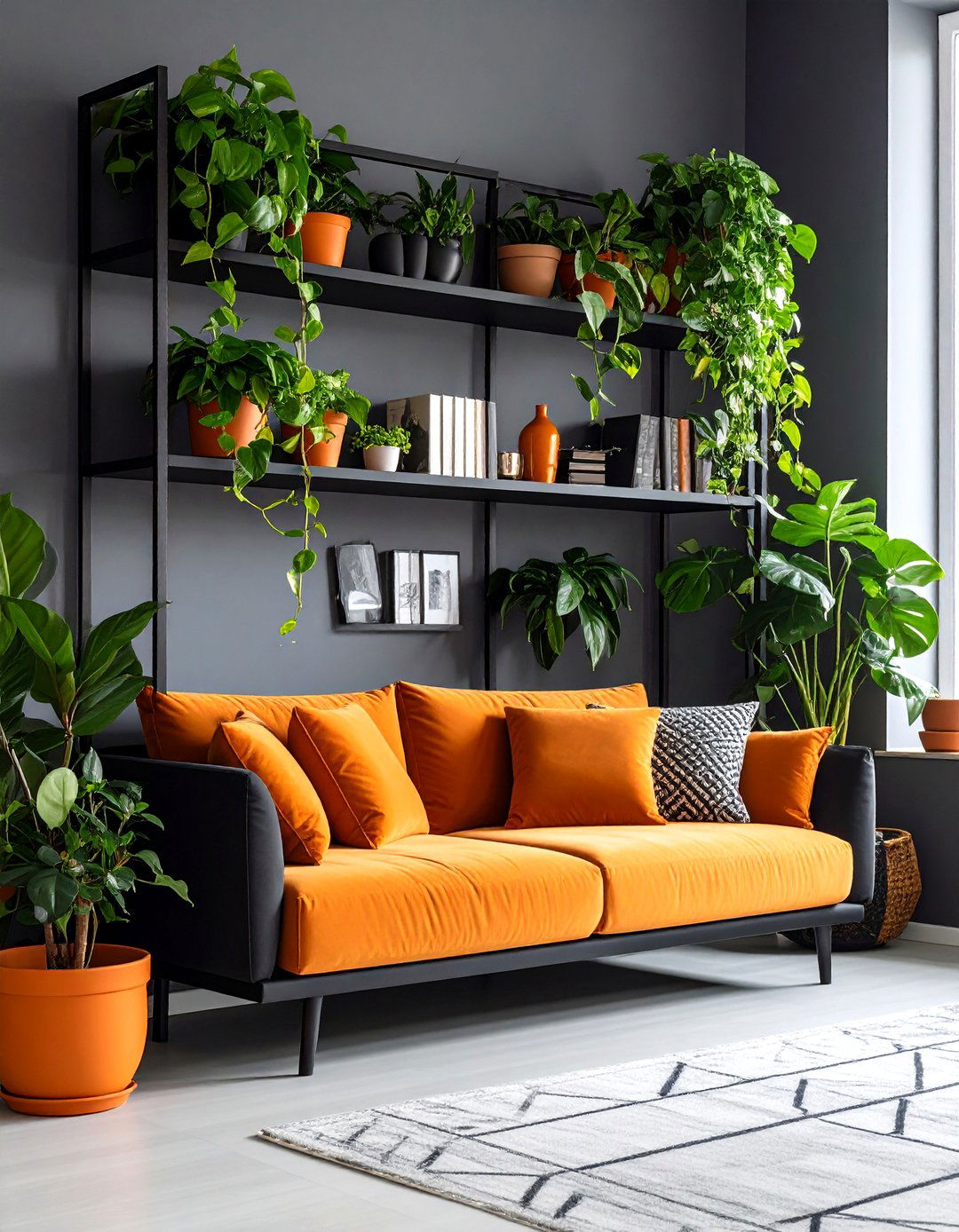

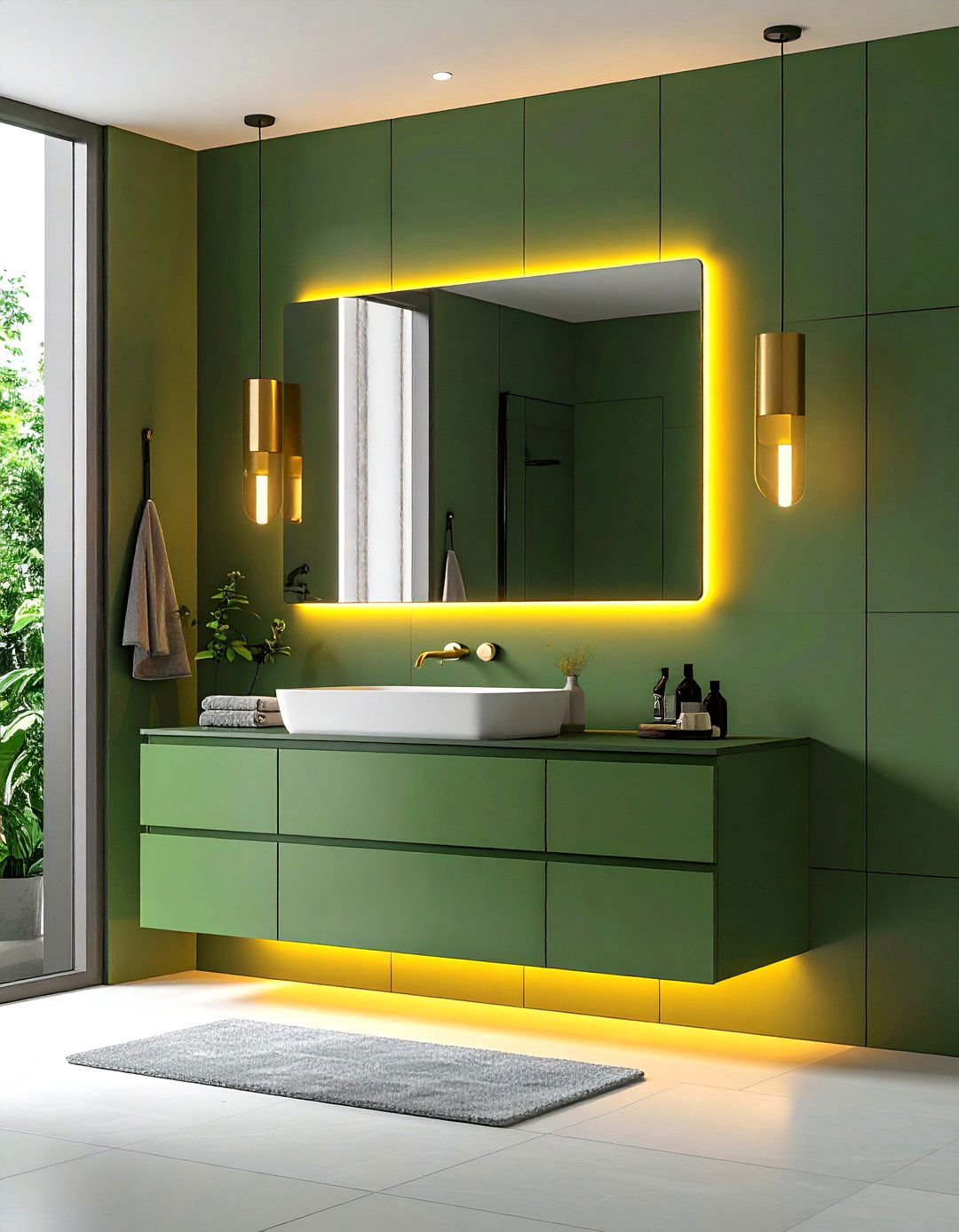
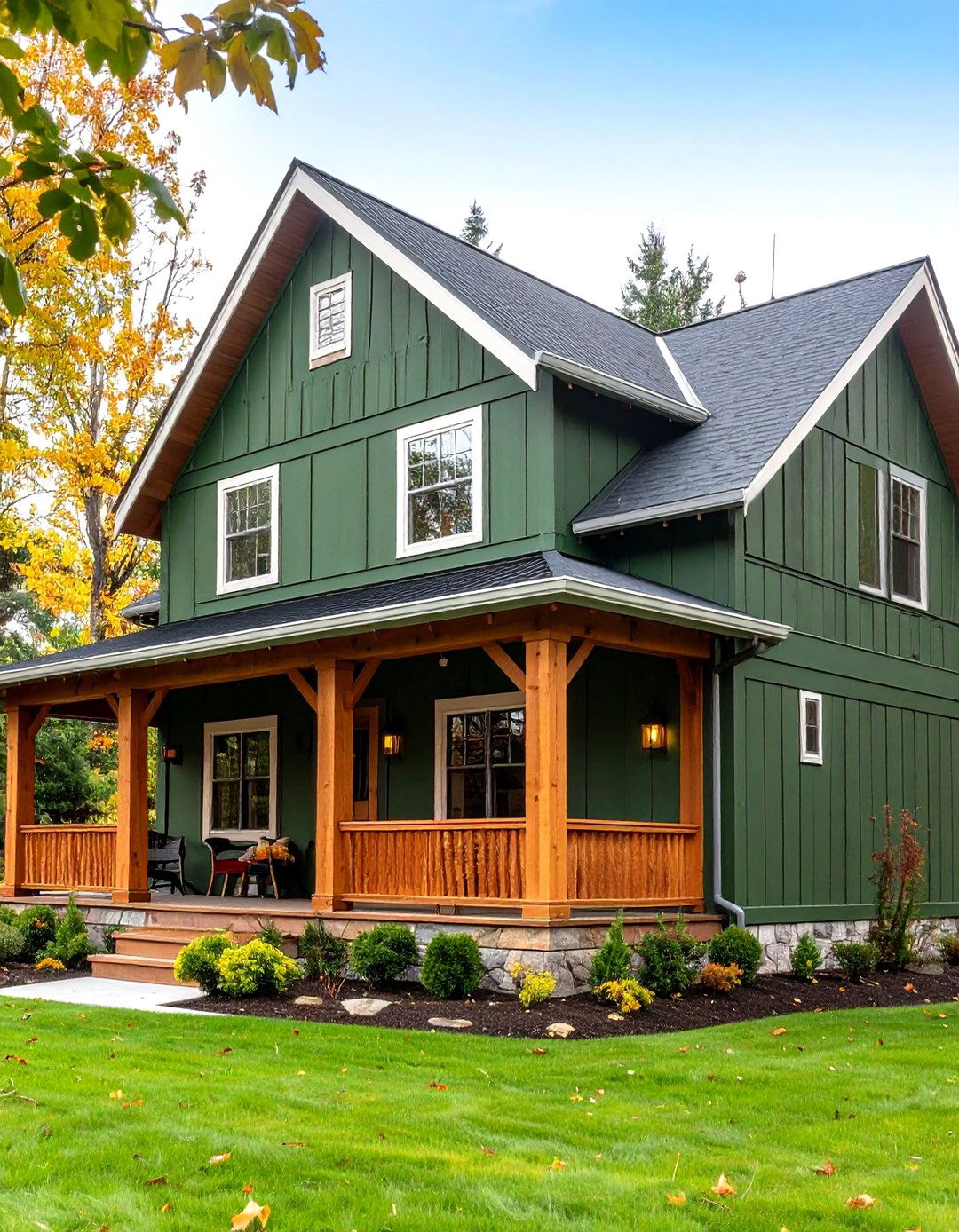

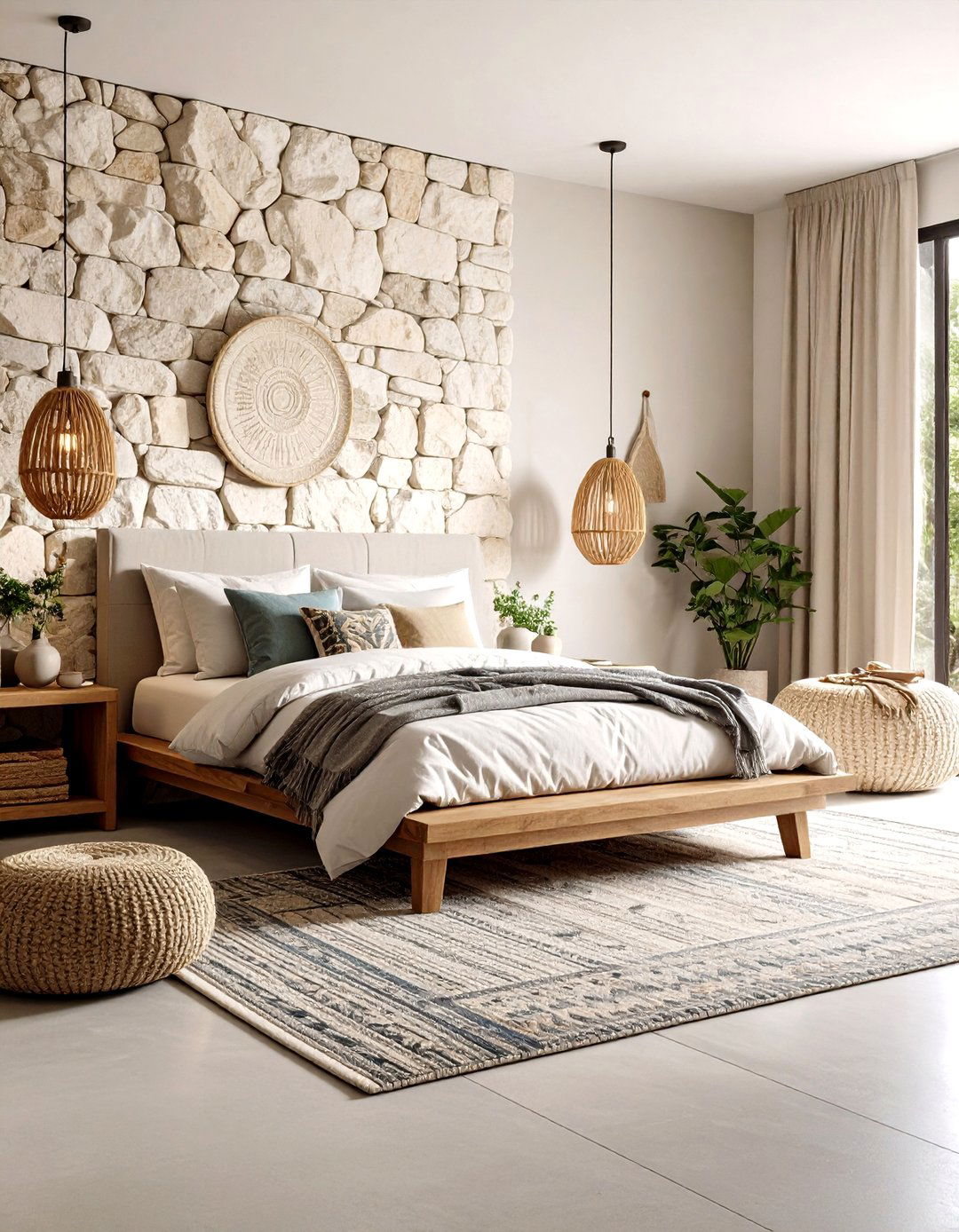
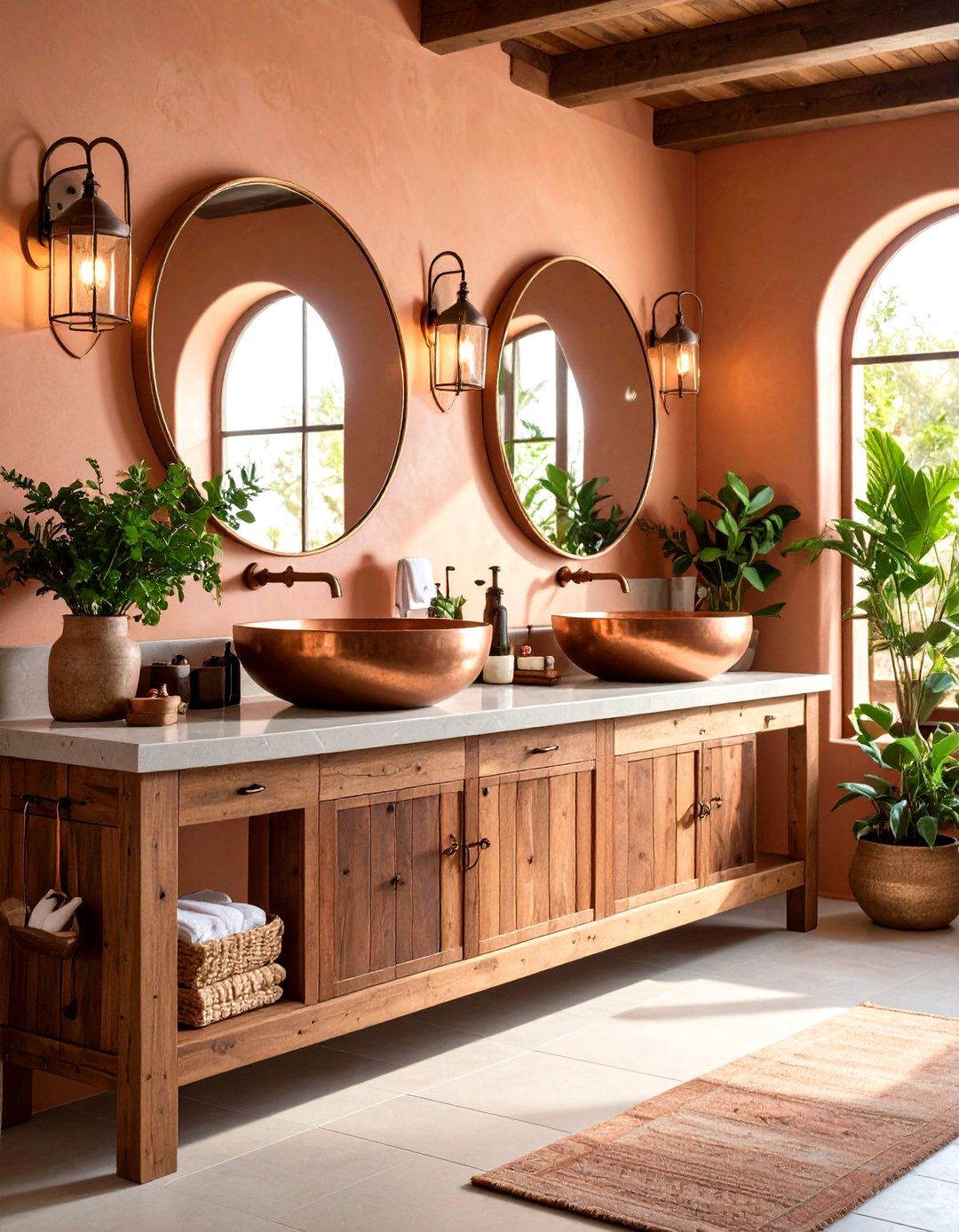
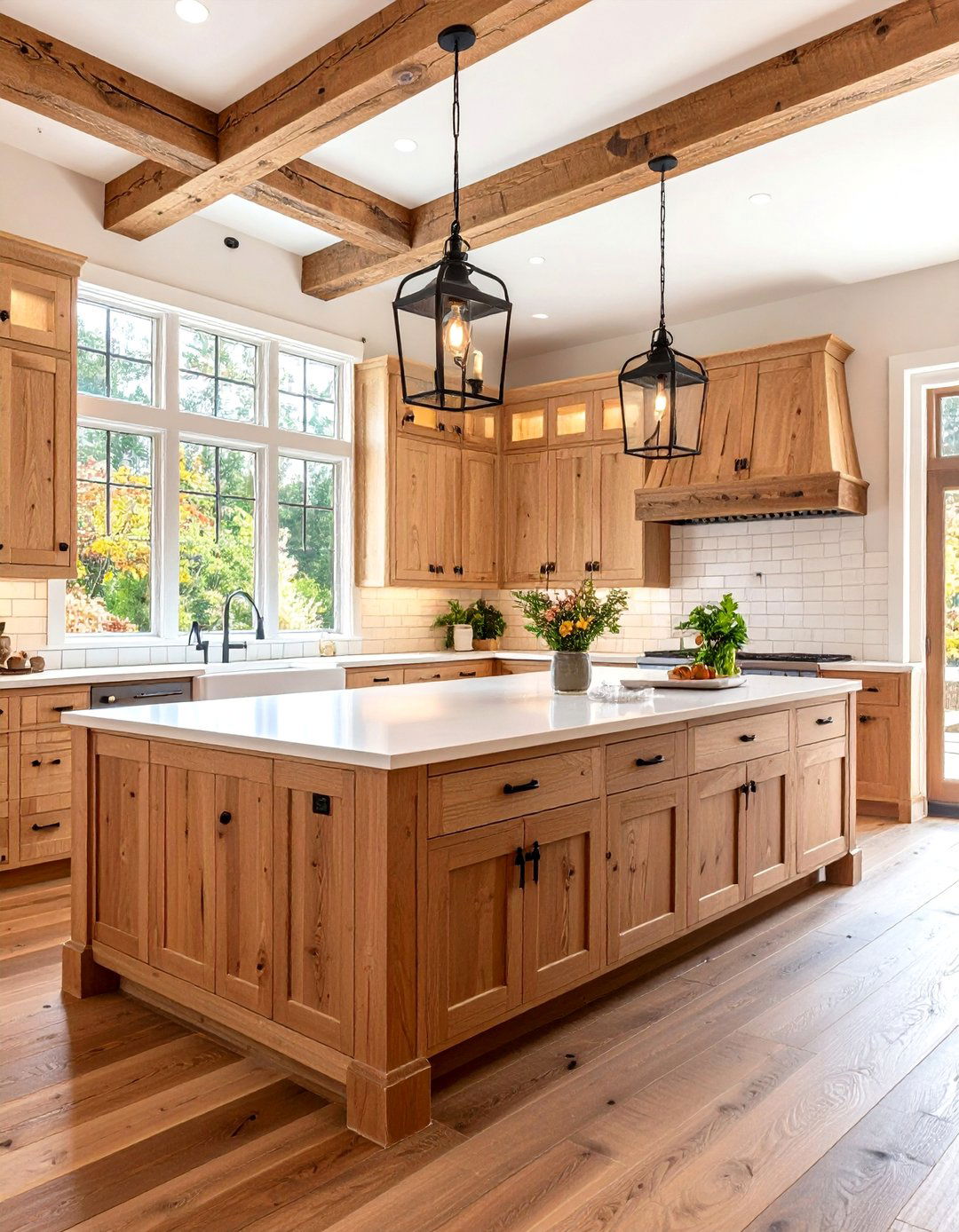
Leave a Reply